















PHOTOGRAPHY THAT GIVES A NEW PERSPECTIVE ON THE ARCHITECTURE OF THE SHORE









































PHOTOGRAPHY THAT GIVES A NEW PERSPECTIVE ON THE ARCHITECTURE OF THE SHORE
























ChesapeakeEye Care andLaser Center canhelp. We’reproud to be oneofthefirst inMaryland to of fer Vitreolysis- Laser FloaterRemoval. Thisis aminimallyinvasive, outpatient procedure whichtakes less than20minutes to remove yourfloaters.
Tuesday, April24th from 6pmto8 pm
Foraneducational talk by Dr.PriscaDiala Retina /VitreolysisSpecialist, to learnmoreabout this state-of-the-ar ttechnology.
Reserveyourspottoday 410-571-8733 x230 cmiller@ ceceye.com Lightfareanddrinksprovided



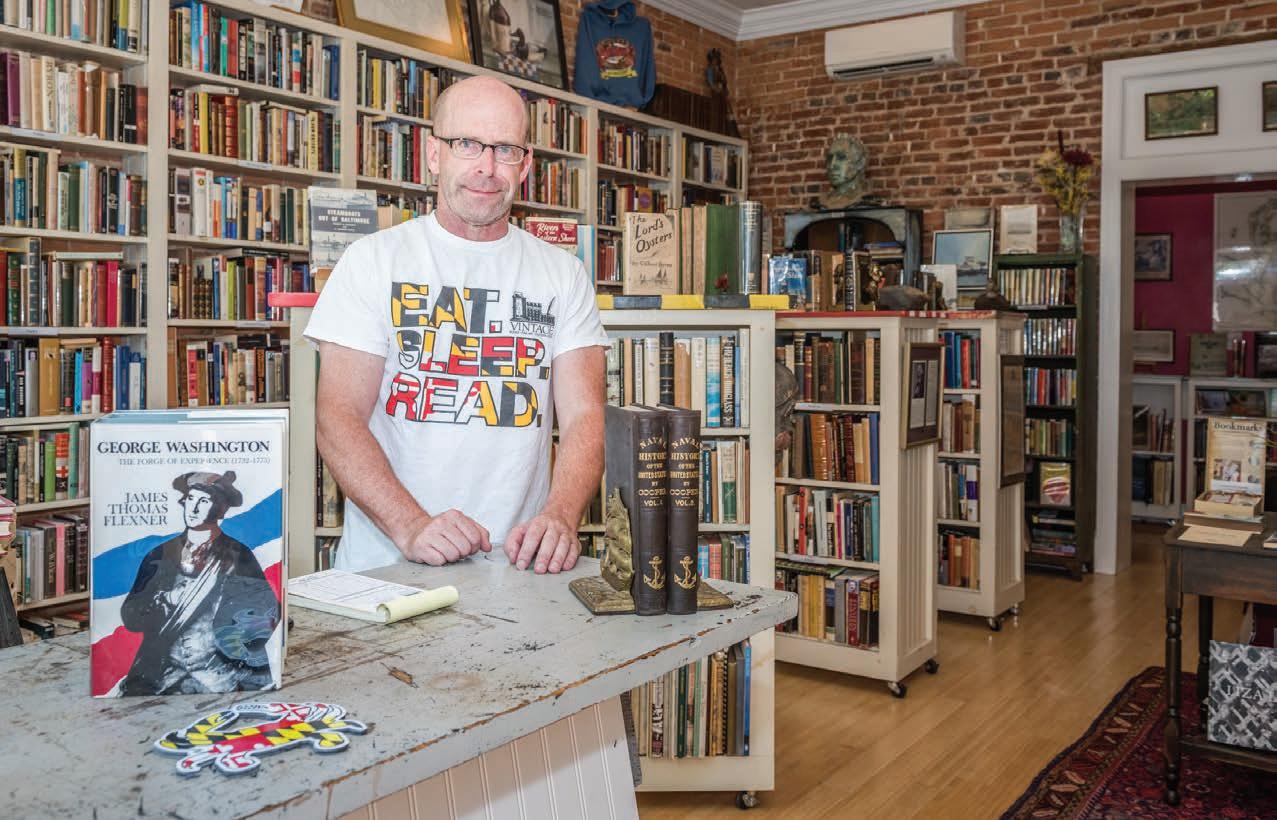

$1,999,000

BROKER (DIRECT)410-310-2021
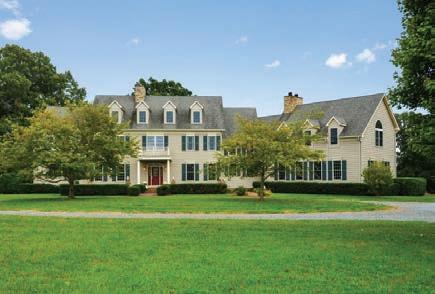

PRIVATE WATERFRONT: Beau ful, private waterfrontestate on 26acresoverlooking the Miles River. Largesunny great room, spacious kitchen, rst oor owner’ssuite, huge recrea on room plusbonus room. Private pier, watersidepool and fabulous screened porch.Easy commute. $1,895,000
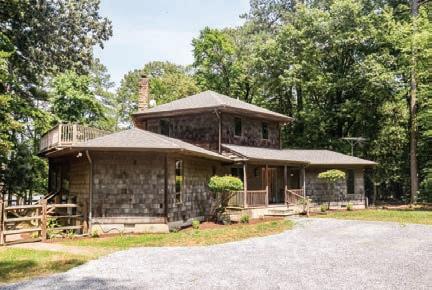
ST. MICHAELS WATERFRONT: Private waterfront home on 4+ acres with open concept oor plan o ers huge 2nd oor mastersuitewith wraparound deck,brick replace,waterviews from every room, screened porches andpier Garage with apartment above.$825,000
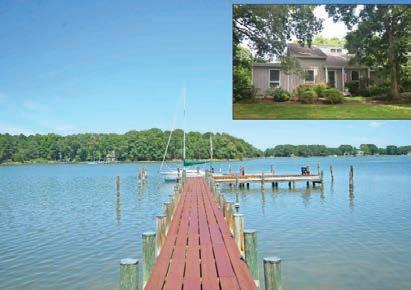
ST MICHAELS: Bring yourboat! Deep water! Up to date, open oor plan St Michaels home with water views, gourmet kitchen, two replaces, rst oor master and reardeck. Shared ownershipof waterfront lotwith deep water boatslip and pavilion $619,000



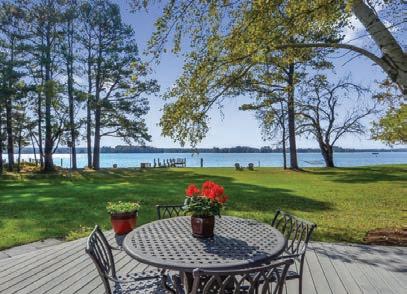

EASTON / ST MICHAELS WATERFRONT: Immaculate waterfronthome with excep onal broadwater views! This four bedroom home is lled with lightand o ers niceopen oor plan,stone replace & gorgeoussunset views.2+acres with pier,&detached 3 car garage includes workshop $1,195,000


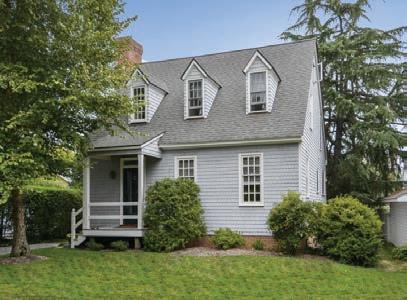
OXFORD CAPE: Approx.2,200 sq. .
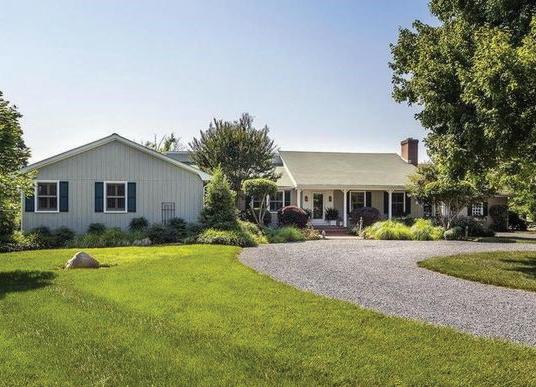

EASTON / ST MICHAELS WATERFRONT: Move in ready 4 bedroom waterfront home close to St Michaels and Easton Sited on 2beau fullylandscaped acres with watersidepool, pier with li , breezy screenedporchand fabulous owner’s suite. Call for more informa on!
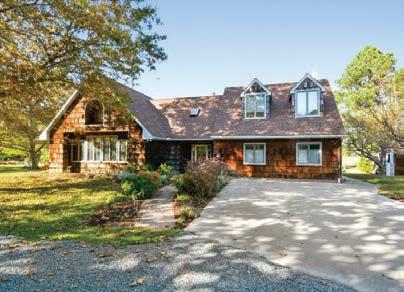

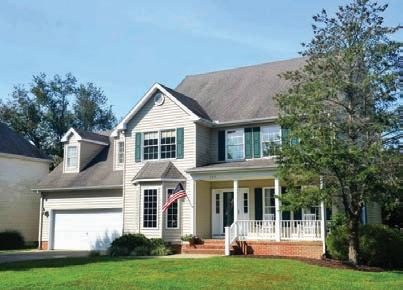


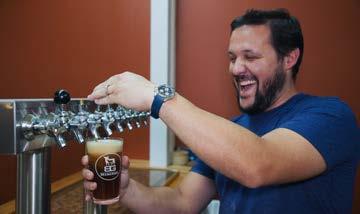
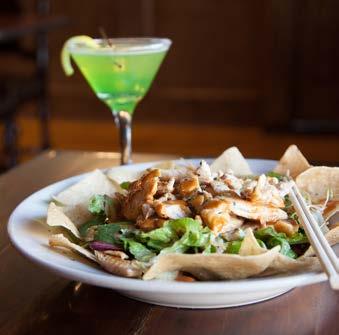
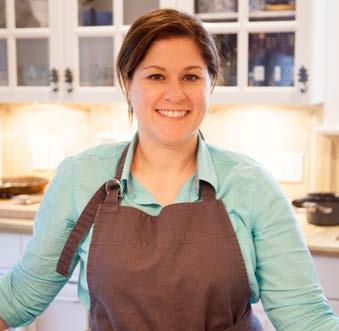
Bull and Goat Brewery
Exploring historic Berlin
Woodworking with Scott Beatty
Jay Fleming breaks the ice
LOCAL
Duck with blood orange gastrique
HEARTHBEAT
Home designs across the Mid-Shore
TASTE BUDS
Pairings from the Market Street Pub
ABOUT
Architect Christine Dayton
SHOP
Gift ideas for building anew
The

Ilove the Eastern Shore — the interesting people, places, history, and charming, yet relaxed attitude make it so unique. I grew up on the Eastern Shore, water skiing on the Tred Avon River, swimming off the Oxford Ferry dock in the summertime, fishing and sailing, and forging close friendships during my youth. But I hadn’t a clue how fortunate I was, nor did I recognize the values being instilled in me by the people and places who make this place so unique.

My father once told me my career would find me before I found it. He was right. I’ve been fortunate professionally, I think in large part because of the hearty candor and work ethic instilled in me by the small and close-knit Eastern Shore community I was raised in. I’ve spent time learning how to be a better sales person by learning how to be a better person.
If you asked me what I am, I’d say I’m a proud father of three and husband to a woman who’s too good for me. If you asked me what I do for a living six years ago, I would’ve told you what I’ve always said — I’m a salesman.
Maryland’s Eastern Shore is a special place for so many reasons, much of which you will read about in this issue of Shore Monthly — unique Mid-Shore architecture; phenomenal horizons and people captured by the talented Jay Fleming; day trips that inspire like that recently taken by one of our writers to Berlin; and talented professionals, like Easton-based architect Christine Dayton.
So if you ask me now what I do for a living, I’ll tell you that I enjoy the privilege of helping the businesses in and around my community on the Shore, large and small, to thrive and prosper financially. As the years have passed, I’ve come to understand and appreciate what it truly means to be part of this beautiful MidShore community.
Jon Ekroos Client Solutions Manager - NXC Media
Correction: Caroline J. Phillips should have been credited as the photographer for the February“High Spirits”feature.

EDITOR
Katie Willis
CREATIVE DIRECTOR
Greg Mueller
CONTRIBUTING PHOTOGRAPHERS
Caroline J. Phillips
Pascale Bernasse
Henley Moore
CONTRIBUTING WRITERS
Katie Willis
Amelia Blades Steward
Sarah Ensor
Laura Wormuth
Denae Spiering
Connie Connolly
Michael Valliant
Caroline J. Phillips
Bethany Ziegler
EDITORIAL CONTACT
410-463-9883
PRESIDENT/PUBLISHER
David Fike
MARKETING DIRECTOR
Betsy Gri n
NEW MEDIA MANAGER
Paul Hagood
ACCOUNT EXECUTIVES
Gail Ruppe
Jon Ekroos
ADVERTISING
CONTACT
443-239-0307
SUBSCRIPTIONS
410-770-4005
Receive Shore Monthly in the comfort of your own home for only $24 a year, or subscribe to The Star Democrat for $138 a year and receive Shore Monthly for FREE.
SUBMISSIONS submissions@ shoremonthly.com


Shore Monthly is published by The Star Democrat. No portion may be reproduced in whole or in part by any means, including electronic retrieval systems, without written permission from the publisher.















AtLondonderry,theEasternShore’sonlywaterfront62+cooperativelivingcommunity,youcan livethelifeyou’vealwayswanted.You’llenjoythebenefitsofhomeownershipwithlessworries andmoretimeforyourself.CallRachelSmithat410-820-8732tofindouthowyoucanstartliving YourLife,YourWay today!












Story by Sarah Ensor
by Caroline J. Phillips










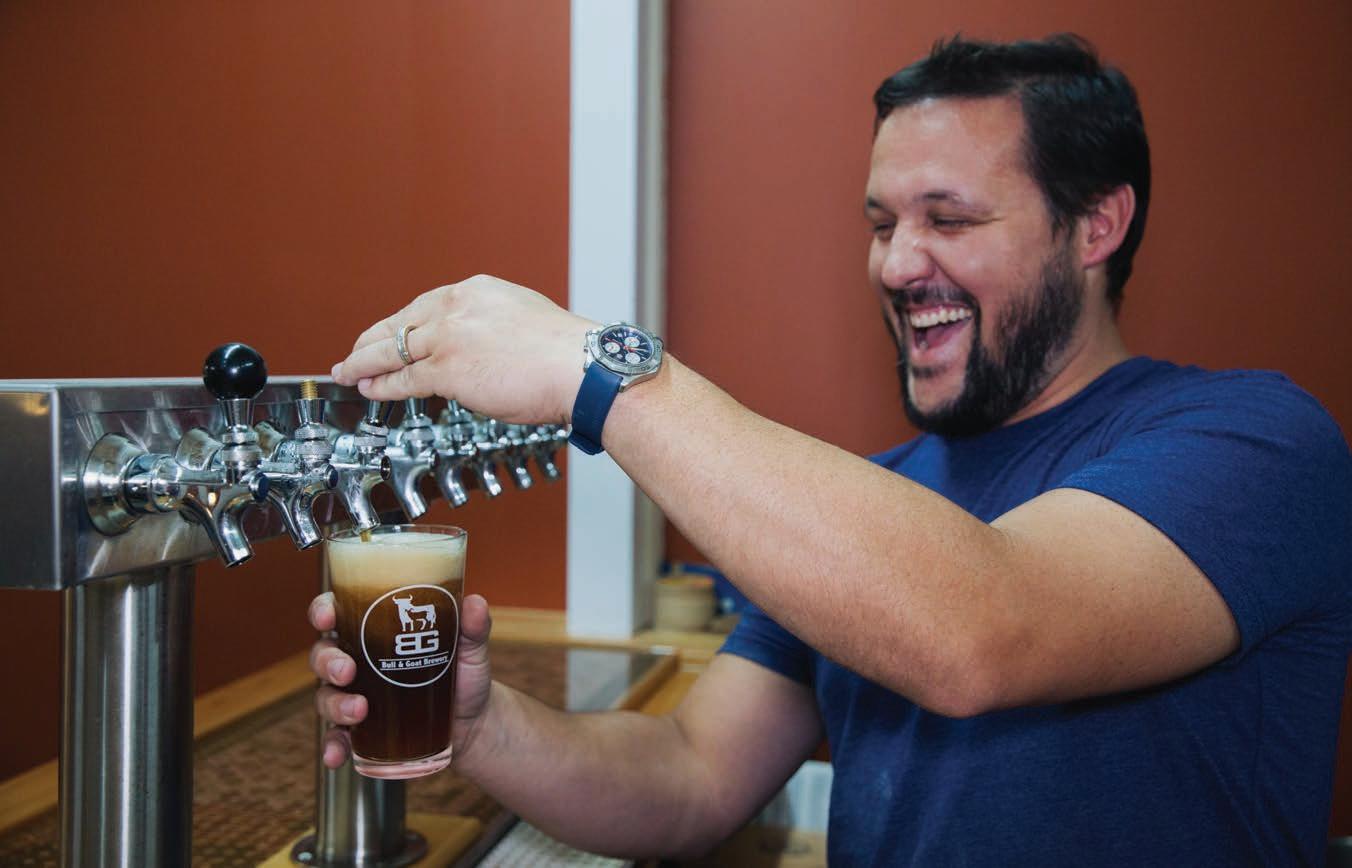

Jake Heimbuch and Jeff Putman started as home brewers about five years ago. After they got the hang of it, they decided to start a business. They put a budget together, and Bull and Goat opened in a 300-square-foot garage in May 2016.
In a parking lot tucked away in Centreville, a lone “BEER” sign with an arrow points to Bull and Goat Brewery, 204 Banjo Lane, suite E. Inside, customers arrive for Friday happy hour.
Jake Heimbuch is swapping out a keg, reconnecting lines, and taking orders from a few customers who have arrived in time for opening.
As he works, more customers arrive. They sit in the plush leather seats around a coffee table, facing a bookshelf stocked with games, such as Battleship, Trivial Pursuit, and Cards Against Humanity. Others find a spot near the farm table toward the back of the brew pub, where a dart game has just started.
People fill in the seats around the bar, which Heimbuch spent hours styling.
Heimbuch’s grandfather collected pennies, and Heimbuch also spent hours soaking them in baking soda, vinegar, and water, later sorting them by color and arranging them in a “B” and “G.” Each of the 2,560 pennies is individually glued to the bar.
As more customers arrive — both to enjoy beer in the tasting room and to fill growlers to take home — the tasting room begins to act as an English pub, albeit with a decidedly American feel. People in different groups enter conversations; some play games. Few have come for a quick visit, most want to spend some time relaxing.
Thursday nights are the busiest at Bull and Goat. Heimbuch’s partner, Jeff Putman, is an avid cycler and has attracted the attention of a group of cyclists who bike 20 miles each Thursday. After their ride, they head to the tasting room.
Bull and Goat is a side project for Putman and Heimbuch, whose primary jobs are selling military-grade inflatable boats. Because their jobs allow them to travel all over the country, they visit as many breweries as they can to learn new techniques and see what others are doing and how they are doing it.
Brewers like to help one another, Heimbuch said, as it’s a supportive community with great camaraderie, and people enjoy sharing tips.
The duo started as home brewers about five years ago. After they got the hang of it, they decided to start a business. They put a budget together, and Bull and Goat opened in a 300-square-foot garage in May 2016.
They swiftly outgrew that space and moved much of their operation to their current location in June 2017. They still use their original space, although it is not part of the tasting room.
The tasting room is housed in an old grain warehouse with 100-year-old wooden floors. In addition to being a tasting room, customers can have growlers and kegs filled there, and Heimbuch and Putman deliver their brews locally to three counties.
Each beer on tap is well-thought-out, and it is difficult to pick a favorite from the tasting flight. The Frank Amber Ale was one of their first brews, and it has stood the test of time. The County Seat is their newest pale ale, a fitting title for a Centreville brewery. They use Maris Otter malted barley, which Heimbuch maintains is the best malt.
“We spend a lot of money on malt to make good beer,” Heimbuch said.
The company is growing steadily. They soon will outgrow their brewing system and have plans to get a bigger system, and possibly, a bigger tasting room.
Bull and Goat Brewery is open from 5:30 to 9 p.m. Thursday and Friday, and from 2 to 9 p.m. Saturday. For more information, visit www.bullandgoatbrewery.com. S




FRANK: An Amber Ale, malty and sweet, heavy in avor and light in feel. With 5.5 percent alcohol by volume and 29 on the International Bitterness Units scale, this amber’s mellow front is followed with a mildly oral nish.
RAFT UP: Witbier, a lovely wheat fermented with a Belgian yeast, with undertones of coriander and citrus. This crazy yeast produces pleasantly exotic avors with simple barley and a heavy dose of malted wheat. This dry and easy to enjoy beer has an ABV of 4.9 percent.
FRONT STREET: Named after the porters who worked Centreville’s small port, this porter is hearty in avor. It starts with hints of chocolate and co ee, and nishes smooth with a balanced barley feel. Front Street Porter has an ABV of 5.4 percent and 30 IBU’s.
67: This IPA is mashed for 67 minutes, and with 67 IBU’s at 6.7 percent ABV, it’s perfectly balanced. Hopped with only citra several times throughout the brewing process, the nose and taste have hints of pine and grapefruit. A small amount of Gambrinus honey malt gives “67” its exceptionally smooth nish.


We help youkeeptogether what you’ve workedso hardtoputtogether
• AssetProtection
• 401(k)Rollovers
• Retirement
• EstatePlanning
• CharitableGiving

• EmployeeBene ts
• Long TermCareInsurance
• BusinessContinuationPlanning
• Financial Wellness
Helpingbusinessesachievetheir nancialgoalssince1999
Of cesconvenientlylocatedinEaston, Salisbury,Annapolisand Timonium.

BeforerollingovertheproceedsofyourretirementplantoanIndividualRetirementAccount(IRA)orannuity, considerwhetheryouwouldbenefi tfromotherpossibleoptionssuchasleavingthefundsinyourexistingplan ortransferringtheminto anewemployer’splan. Youshouldconsiderthespecifi ctermsandrulesthatrelateto eachoptionincluding:theavailableinvestmentoptions,applicablefeesandexpenses,theservicesoffered,the withdrawaloptions,thepotential flexibilityaroundtakingIRSrequiredminimumdistributionsfromtheoption, taxconsequencesofwithdrawalsandofremovingsharesofemployerstockfromyourplan,possibleprotection fromcreditorsandlegaljudgmentsandyouruniquesituation.NeitherNew YorkLifeInsuranceCompanynorits agentsprovidetaxorlegaladvice.Consultyourowntaxandorlegaladvisorsregardingyourparticularsituation. BrettM.Sause,RegisteredRepresentativeofferingsecuritiesthroughNYLIFESecuritiesLLC,MemberFINRA/ SIPC, aLicensedInsuranceAgency1954GreenspringDrive,Suite700, Timonium,MD21093,410.321.6161. BrettM.SauseisanagentlicensedtosellinsurancethroughNew YorkLifeInsuranceCompanyandmaybe licensedtosellinsurancethroughvariousotherindependentunaffiliatedinsurancecompanies.BrettM.Sause MemberAgent,TheNautilusGroupis aserviceofNew YorkLifeInsuranceCom-pany.TheNautilusGroupas wellasitsemployeesandMemberAgentsdonotprovidetaxorlegaladvice.AtlanticFinancialGroup,LLCis independentlyownedandoperatedfromNYLIFESecuritiesLLCanditsaffiliates. SMRU176105001/17/2020




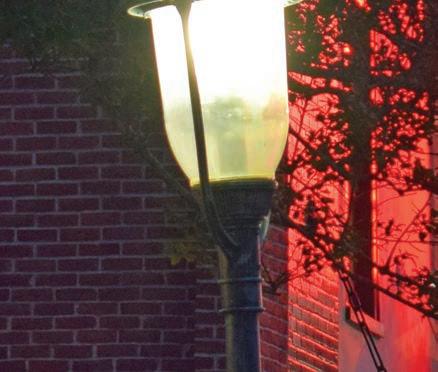
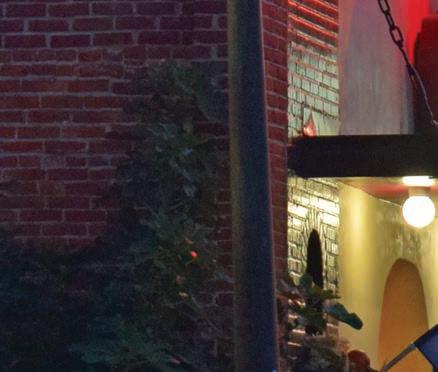
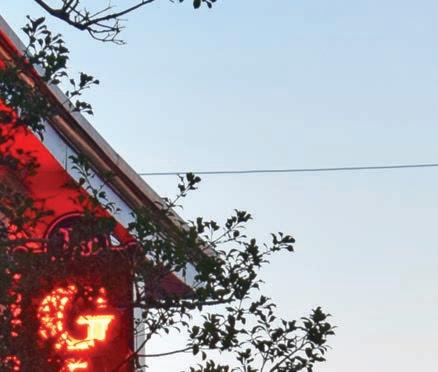
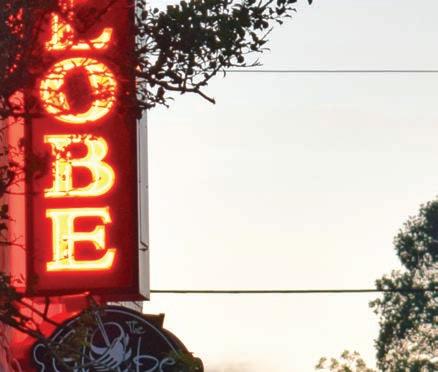



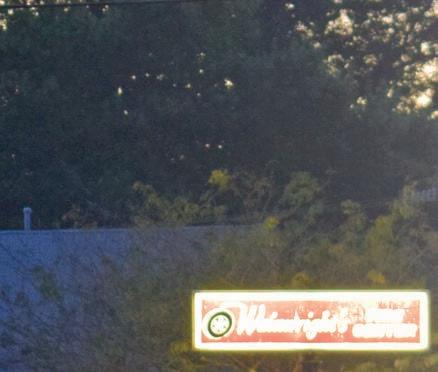


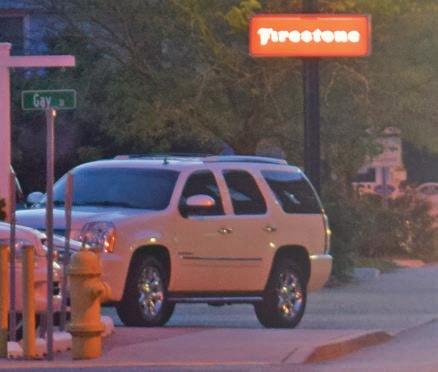










PPicturesque and quaint, Berlin is a hidden gem in Worcester County, bearing history, gourmet eats and treats, arts, antiques, and much more to explore. But despite it’s quintessential old-fashioned atmosphere, Berlin is a modern town with all the bells and whistles, from great shopping to free WiFi throughout the town. Rich with interest, Berlin is the perfect place to spend the day or for a weekend getaway on the Eastern Shore.
Begin your journey with a walk around the nature trail at Stephen Decatur Park, a 21-acre area, including tennis and basketball courts, a fitness trail, and a waterfowl pond. This quiet, family-friendly space was named for the naval hero who played a major role in the Battle of Tripoli Harbor.

According to the White House Historical Association, Decatur would go on to serve in the First and Second Barbary Wars, as well as the War of 1812, among others. The park was created from a section of the Decatur family farm where he was born in 1779.
Adjacent to the park are Burley Manor and Burley Cottage on Main Street, named for the original Burley Plantation, which encompassed a 300-acre area, a land grant dating back to 1677. According to www.berlinmainstreet.com, early travelers to the area stayed on what is now Main Street at the Burleigh Inn — the namesake of the town, as historians say the contraction of the two words became “Berlin.”

Burley Manor and Burley Cottage are architecturally unique, sharing columned front porches with sawtooth arches dating back to the 19th century, both built just before the incorporation of the town in 1868.
Despite the fact that the downtown
area suffered through three large fi res at the turn of the 20th century, a few of the original buildings and homes still exist.
Continue to historic downtown Berlin to experience the Arts and Entertainment District. With more than a dozen different artists and galleries, there is something to appeal to all tastes.
The eclectic downtown area also is home to numerous antique stores. A full day can easily be spent getting lost in antique shops — Pitts Street Antiques, Town Center Antiques, Culver’s Antiques, and Toy Town Antiques and More, which features antique toys and comic books sure to tantalize your inner child. Old and retro items from days gone by are righteously priced for visitors to take home a piece of Chesapeake-themed history — old oyster cans, nautical memorabilia, and local paintings and photographs.
Shopping isn’t the only activity in Berlin — you also can enjoy some entertainment while you dine at the historic Old Globe Theater restaurant. The Globe, still boasting its original marquee over the front doors, offers culinary expertise in an atmosphere reminiscent of the roaring ‘20s and Vaudeville.
Continuing the tradition, the Globe hosts murder mystery dinners, local art exhibits, and live music on stage. For a full schedule of its events, visit www. globetheater.com.
If you’re looking for a sweet treat afterward, stop at Main Street Enchanted Tea Room for a relaxing cup of tea and pastries. Located at 7 S. Main St., the tea room offers 48 selections of tea flavors and varieties, and is decorated with antique tapestries, whimsical knicknacks, and elegant table settings. It also maintains a gift and collectibles shop to entice
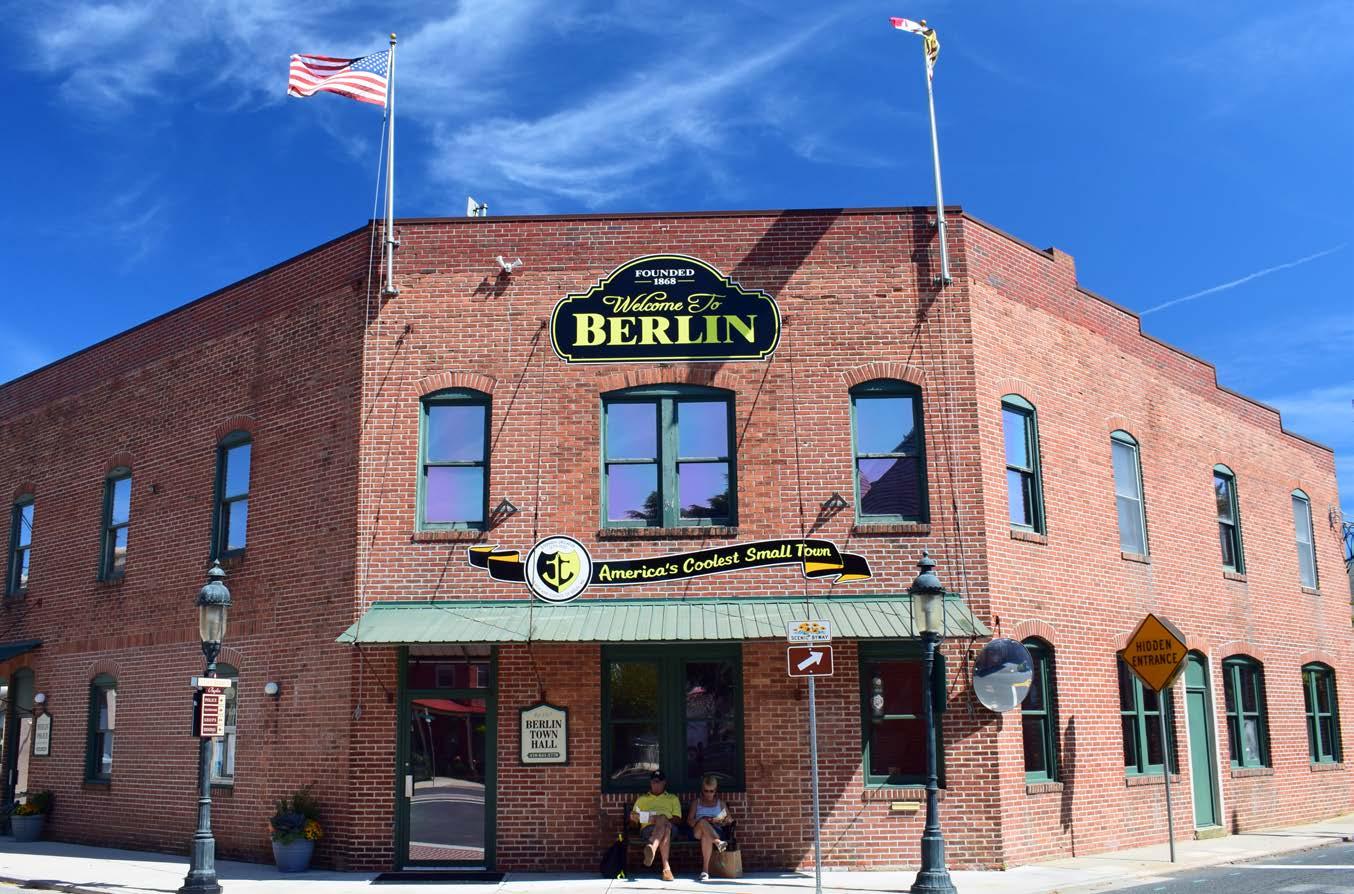
your nostalgic senses. Find its hours and menu at www.mainstreetenchantedtea.com.
If you’re not ready for a nap after indulging in Berlin’s gourmet foods, visit the Calvin B. Taylor House and Museum. This restored 19th-century manor house has been converted into a museum of historic and local memorabilia. With its majestic presence at 208 N. Main St., the Taylor House was built in 1832 for Isaac Covington, a trader and store owner. Its namesake, however, was Calvin B. Taylor — a teacher, lawyer, and founder of the Calvin B. Taylor Banking Company — who lived in the house with his wife from the 1890s until his death in 1932, according to the museum website, taylorhousemuseum. org. The museum is open from Memorial Day through Labor Day, and special
events celebrating the days of yore occur periodically throughout the year.
If you’re planning to stay the night, choose the Atlantic Hotel for its rich history and classic, refined style. Built in 1895, the rooms and suites are decorated in the style of the Victorian era, and lay claim to names from literature, such as “The Bronte Room,” “The Tennyson Room,” and “The Byron.”
The hotel charms with small-town character mixed with a regal air to create a unique experience for its guests. Find room availability at atlantichotel.com.
With its close proximity to Assateague Island and Ocean City, Berlin offers the best of both worlds — old and new — transporting visitors to an old-fashioned hometown with a touch of the 21st century. S




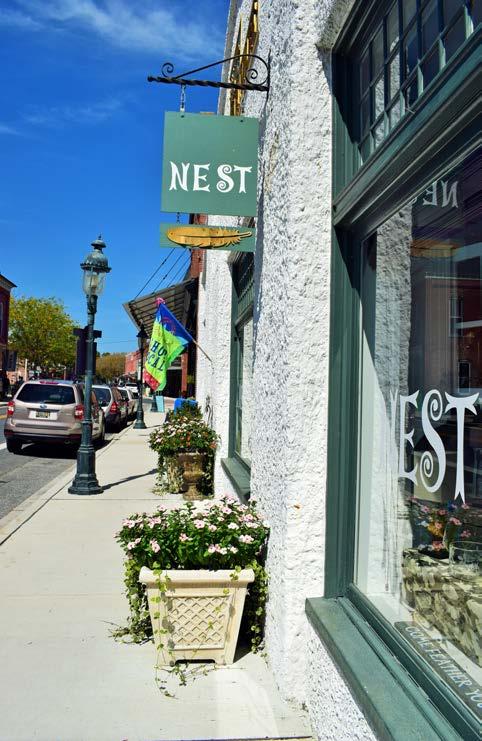
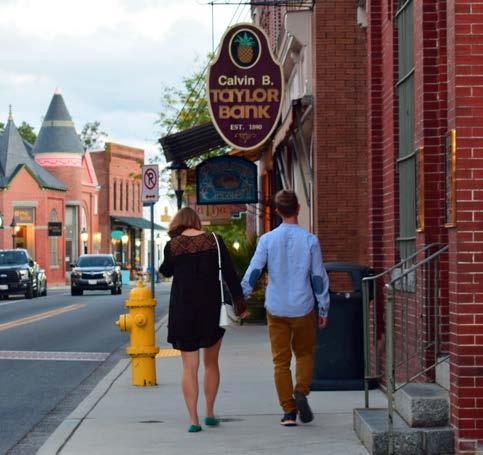
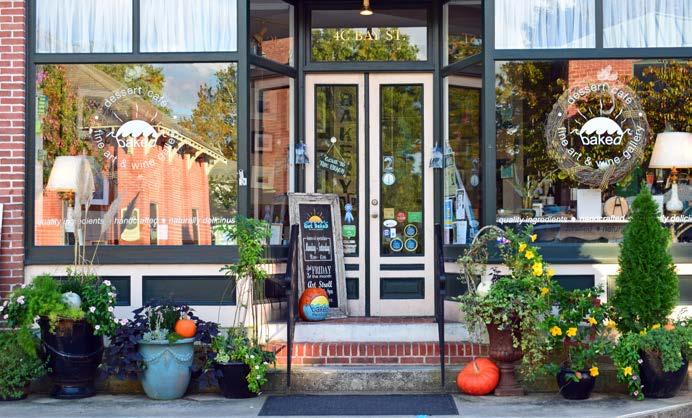









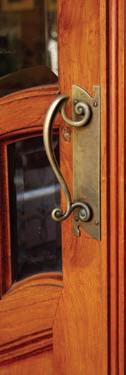






















































































































































































































ProudEventSponsor

Comemeetlocalfamilieslooking forideasforkids!Ifyouare acamp ordayprogramdirectorthisfamily friendlysettingisexpresslyforyou. Thiseventisdesignedtopromoteand shareyourprogramfor acoupleof hoursin arelaxedsetting.
Joinusin arelaxedsettingto learnaboutenrichingactivities acrossTheEasternShore.
Enjoylightrefreshments,engagingfamilyactivities andwingiftcertificatestolocaleateries. Free
•YMCAoftheChesapeake
•CampMardela
• YMCAoftheChesapeake
•ChesapeakeCollege
• CampMardela
•CritchlowAdkinsChildren’s CentersSummerCamps
• ChesapeakeCollege
•KilnBornCreations
•GirlScoutsof ChesapeakeBay
•CampWright
•ChesapeakeBay
Environmental Center
• CritchlowAdkinsChildren’s CentersSummerCamps
•AvalonTheaterSummer Camps
• KilnBornCreations
•HogNeck GolfCamps
• AvalonTheaterSummerCamps
•PhillipsWharfEnvironmental CenterCamps
•TalbotCounty ParksandRecreation
•Camp Pecometh
• PhillipsWharfEnvironmental CenterCamps
•MidShoreMartial Arts












“Woodworking has always been therapeutic for me,” he said. “I fish a lot, I play golf, but I’ll come into the shop on a Saturday morning and put music on, and I could stay here all day.”






Beatty started learning furniture-making techniques when he was 6 or 7 years old. It was a neighbor in Easton, Herb Bradley, who got him interested. Bradley had polio, braces on his legs, and would get around the shop on crutches. His enthusiasm stuck with Beatty.



Furniture-making slowed down

















Shore Bancshares Inc. CEO Scott Beatty takes us inside his workshop and gives some thoughts on the therapeutic nature of working with your hands




Story by Michael Valliant







| Photos by Caroline J. Phillips
while he was in college, but when he and his wife Nancy got married, he set to work making things they needed — from benches, to tables, to boxes, and beds. The last piece of furniture he completed was six or seven years ago, when he made a gun box for his daughter.


And then came turning bowls.



“I turned bowls a little bit when I was younger, and then I hit a point where I said, ‘you know, I don’t need any more furniture,’” Beatty said. “And the furniture



projects, they take a long time, too. So you get a little more instant gratification turning bowls than you do with furniture.”
He uses mostly hard woods, such as maple, cherry, or pecan. And he’s got friends who keep an eye out for interesting wood, including tree companies and loggers, who will bring by various logs or trees, and who might get a custom salad bowl out of the exchange.
Beatty doesn’t turn bowls to sell or show them, he mostly makes them for family and friends or donates them to charity auctions. One of his goals in turning a bowl or box is to create something with a purpose.
“I make bowls a little thicker than a lot of people do. I can make them really thin, but people are less inclined to use them,” he said. “I like to make things that people will use.”
When he gets wood in, Beatty often
will turn it when it’s green, which then will change shape and elongate as time passes. He’ll let it sit for about a year, and then turn it again into the shape he wants.
In his shop, he points out a piece of pecan from Bay Street, where the offices of Beatty Satchell and Company once were (the certified public accounting firm he helped found, and where he was a partner for 25 years). He pulls down a piece of maple that a friend brought over, and a piece of walnut that came from the estate where they filmed the movie “The Wedding Crashers.”
Beatty put his wood shop together in 1976. It’s changed over the years. At first, he didn’t have heat, and then he added a wood stove and later a wooden floor. He’s acquired tools and machines. Depending on his work schedule and what his grandchildren are up to, he spends at least eight hours a week
In his wood shop, Scott Beatty shows the skill of a craftsman and the enthusiasm of a child. You wouldn’t guess you are talking to the president and CEO of Shore Bancshares Inc. But Beatty’s two worlds inform each other.

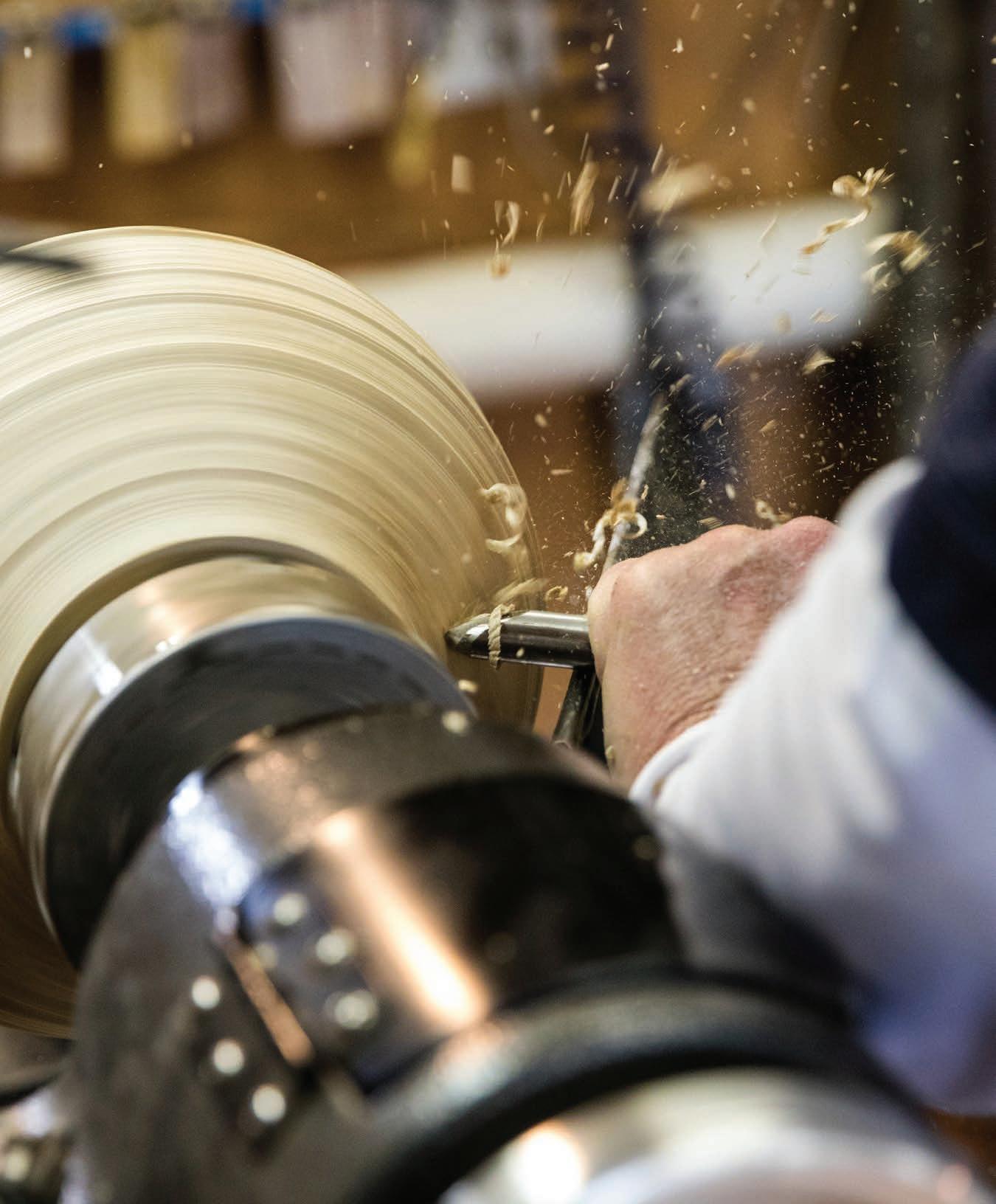

“I LIKE TO MAKE THINGS THAT PEOPLE WILL USE”


turning bowls and working on different projects, especially looking forward to cooler days in the now heated shop.
In the past six or seven years, Beatty has turned between 500 and 600 bowls. His primary tools to work with on the lathe are gouges and scrapers. He has grinders that allow him to sharpen his tools in the shop, which is a skill unto itself.
One of the differences between furniture-making and turning bowls has a lot to do with the wood.
“Every piece of wood is different when it comes to turning,” he said “If you are going to build a piece of furniture, typically you’d go buy some mahogany and get the wood you need, and follow a plan, and take time to build it. With turning, every time I dig into a piece of wood, it’s all different.”
Beatty recalls making a series of three boxes, which were the same in terms of dimension and scale, and when they went for auction at a charity, one went for $500. He’s also given turning demonstrations in his shop for auction winners from Pickering Creek Audubon Center and Adkins Arboretum.
Beatty’s love of family comes through in his shop. He shows a bowl that one grandchild helped decorate and talks about turning a bowl out of canary wood — an exotic wood — for a new grandchild. He’s passing on a bit of what he knows.
“My oldest grandson, who turned 6, turned his first bowl about eight months ago,” he said. “As they get older, I can adjust the height on the lathe.”
Time in the shop doing what he loves is an end unto itself — it’s therapeutic and life affirming. If he lets his mind ponder what he’s doing, there is gratitude and hope mixed in.
“It’s kind of cool to take something that would generally wind up in someone’s fireplace or in a landfill,” Beatty said. “And who knows, maybe 100 years from now, someone will still be using some of these.” S


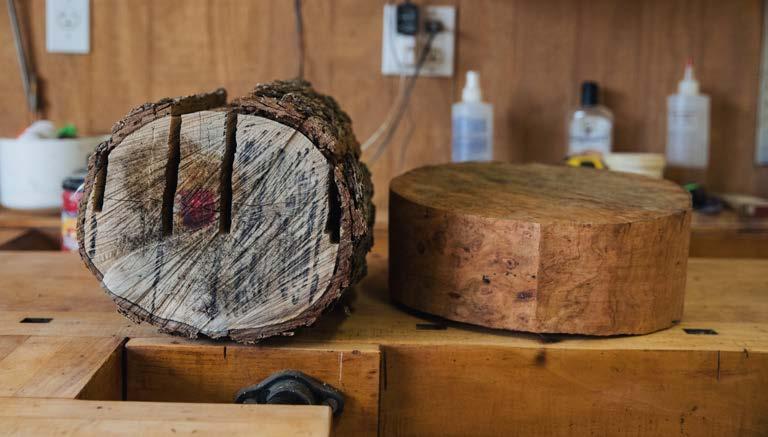
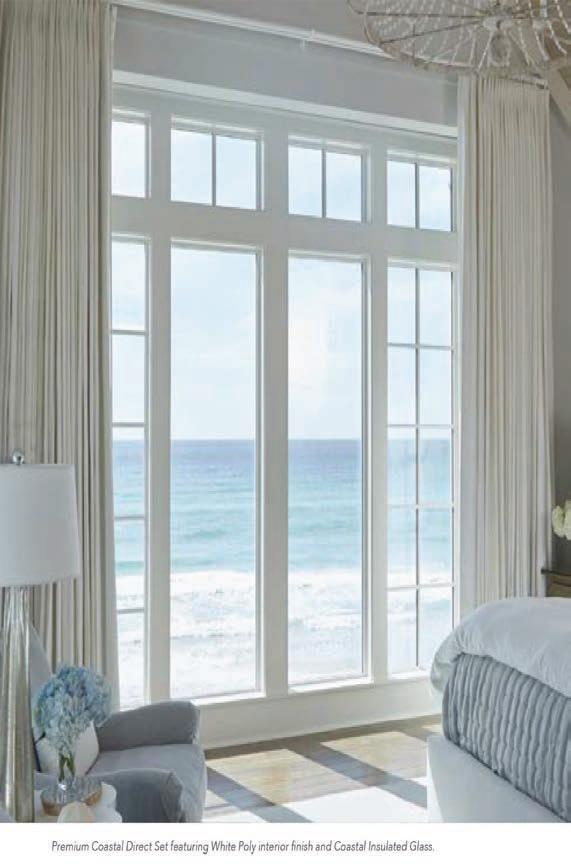



DiscoverIntegraceBayleighChase
Easton’sonlyfull-serviceLifePlanCommunitywitha continuumoflifestyleoptionstosupportyou:
IndependentLiving
Activelivingandbeautifulhomestofitanystyle
AssistedLiving &ComprehensiveNursing
Individualizedsupportin acomfortableenvironment
Rehabilitation
Designedtogetyoubacktothelifeyoulove
NeurocognitiveSupport
Ahostof residentialandcommunity-basedopportunities; morethanjustmemoryanddementiacare







Story and photos by Caroline J. Phillips

Many of those who spend time around the Chesapeake Bay are captivated by its beauty and charm. The sunsets, the shoreline, the natural architecture — the uniqueness of the Eastern Shore is constantly captured by cell phones and cameras. Everyone has their own perspective of what makes the Chesapeake Bay area special, and local photographer Jay Fleming has a point of view that truly is captivating.
As the son of a National Geographic photographer, Fleming grew up in Annapolis with a camera in hand and a passion for capturing stories. At 13, he started tagging along on assignments with his dad, Kevin Fleming, using a Nikon n90s film camera. Once he grew up and got his driver’s license, Fleming would shoot wildlife and landscapes on his own, mainly from his kayak along the water.
Since then, he’s been
documenting stories along the Chesapeake Bay — his own backyard. Those stories include a variety of people interacting with the water — whether it be fishing, crabbing, oystering or boating — as well as wildlife on the water and under the water.
When asked what his favorite thing to photograph is, he replies, “I could safely say anything on the water.”
When Fleming isn’t taking his boat out of Annapolis or

Crisfield, he sometimes travels to other parts of the country on assignments. But he always finds the Chesapeake Bay particularly enchanting compared to other bodies of water, he said.
What draws him toward this landscape is the history of people working on and interacting with the water. He says the landscape of the Chesapeake Bay is different in that, “there are so many creeks and rivers to explore in the watershed.”







More than ever, he says, it’s important that we document life along the Chesapeake Bay. With environmental issues taking center stage, what we see now when we cross the Bay may not always be this way. Fleming knows this.
He constantly has a camera in hand to document “the ways” of the Chesapeake. In his first book, “Working the Water,” he was able to represent all four seasons of watermen along the Maryland and Eastern Shore of Virginia waterways. It’s an intimate look at the true lives of the men and women whose lives depend on the Chesapeake Bay.
Fleming currently is working on putting together a new book about life on Smith and Tangier islands. With this book, he says he wants to document all aspects of the
More than ever, it’s important that we document life along the Chesapeake Bay. S
unique lives of Smith Islanders and Tangier Islanders — the watermen, the infrastructure, architecture, family life, and religion. Since not as many families make their homes on these remote islands, their culture slowly is fading, and Fleming wants to document it before it’s gone, he said.
Fleming’s photos stand out alongside a lot of other wildlife photographers with a sense of true documentation rather than just capturing an image. There is a bit of action that comes from both the subject and Fleming himself, since he often is in a kayak or in the water, capturing his subject.
Fleming, by capturing the uniqueness of the Chesapeake Bay and its horizons, has been able to capture the true Chesapeake that many of us know and want to cherish for years to come.
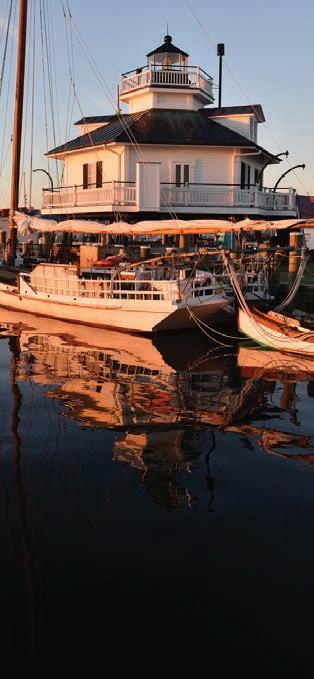



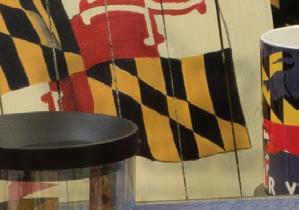







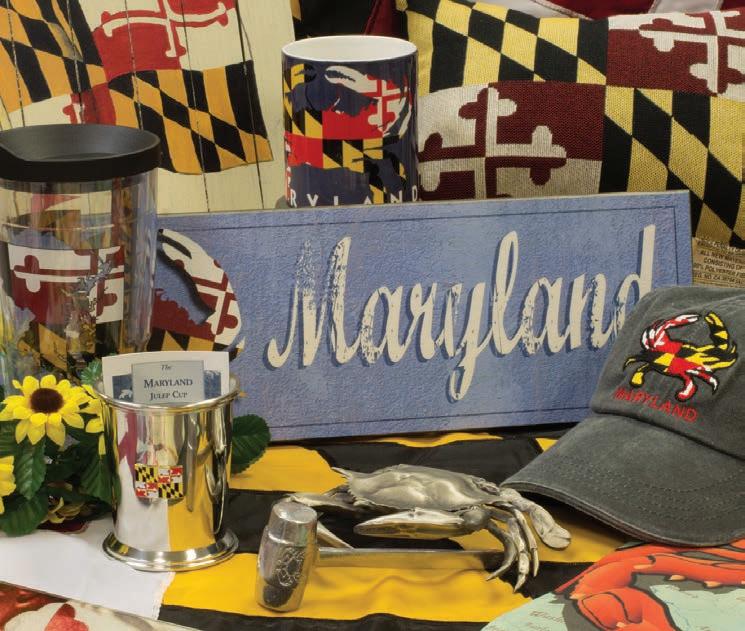

Increte, BAAR(Bay Area Associationof Realtors), BayTimes, WyeRiver Conference Center, ADolce Property,SafeatHome Senior Care, ProspectBay Country Club, Roof Center, Construction Servicesand Supplies, Inc, Kate Spade, BayviewPortraits by Cindy Sigmon, Harris Crab House, Hemingways, ArtCademy, e Narrows, Riley Construction,Wye River Conference Center, A Dolce Property, Island Furniture Studios, e Shore Update, Lundburg Builders, Salon Atelier, Maid Healthy, Holiday Inn Express, Chespeake Hearing Centers, Miltec, Free State Insurance, McCrone Realty Navigator, Hawk Marketing, Timeleigh Solutions












































"Reality is merely an illusion, albeit a ver y persistent one. " - Albert Einstein
How many times have you heard the saying “Perception is reality”? It unfortunately holds true in many aspects of our life. For example, if we see someone in a nice car we immediately believe they are wealthy and if the gallon of milk is expired, it’s got to be sour. We are all guilty of creating our own perception from false illusions is stands true especially in the funeral industry when it comes to cremation.
Any undertaker will admit, if they had a nickel for ever y time someone said, “I just want cremation”, they’d all be retired on a beach somewhere! Nonetheless, it is a statement made ti and time again merely because one of the ptions is that cremation is a single step. In y, that statement is the same as saying “I’d ries with that” before even ordering your eburger. You see when we state we want ation we are simply providing the answer e question, what to do with the body, and what is to be done upon passing We are tting about the steps necessar y to get to that point.



der to breakdown cremation, we need to e things into four important questions: n to do cremation, how will life be honored, will the cremated remains need to go and where are the cremated remains to go four areas will provide any undertaker the y necessar y to the statement “I just want ation ” Let’s explore each of them
n to do cremation is something often not even considered Upon the receipt of legal documentation from the doctor and state of Mar yland, an undertaker can only then begin to schedule cremation Unfortunately, not many funeral homes own a cremator y, so scheduling this based around a request may not be available. But for those who do own a cremator y and oversee the entire cremation process, we can o er this process at any time the family chooses We see this often when families request holding a visitation for family and friends, much like a








traditional funeral, and after wards rather than going to a cemeter y, the individual is cremated Other delays in when to do cremation could be based around a family member wanting to see the individual one nal time, religious customs or perhaps it is simply a personal request of a particular day that cremation should be carried out. Whichever the reason may be, when to do the cremation process is a major question that accounts towards the nal plan
When cremation is selected, a wide variety of options for honoring the life of a loved one is something that is often explored is life celebration could be held at the local pub, a backyard, event center and now even the good ol' funeral home Yes, modern day undertakers have transformed their o erings to now include food, drinks, music, bands, custom tokens of remembrance and all the inner workings of a true celebration, much like that of a wedding reception, anniversar y party or milestone birthday.
What to place the cremated remains into depends on where the nal placement is to be – covering the last two considerations If a family is thinking of water scattering, the urn for the cremated remains should be biodegradable when placed in the water. ere are urns meant speci cally to be placed in a columbarium, to be buried in a cemeter y, or to be displayed in a family’s home. Or perhaps it is to grow back slowly in the form of a plant in your ver y own backyard yes, a tree urn is even available today!!
The perception of almost anything can easily become reality for all of us With this simple breakdown of options, we can all now see that there is a bit more to the idea of cremation. So, next time you have a nice car behind you, maybe spot them money for their toll, and the next time you ’ re at the drive thru, be sure to request the sandwich before stating fries are to go with it
Ryan, certi ed preplanning counselor and licensed funeral director with Fellows, Helfenbein & Newnam, assists families in creating one of a kind unique life celebrations He can be reached at 410-758-3897 or Ryan@fhnfuneralhome.com

Architect Christine Dayton talks about the appeal of designing on the Shore, and how to bring its fresh environment indoors
Story by Amelia Blades Steward
Photos by Caroline J. Phillips
Open, airy spaces, clean lines, with views that bring the outdoors in, are signatures of the designs of architect Christine M. Dayton of Easton. Dayton, who has been in business 24 years as principal/owner of Christine M. Dayton Architect P.A., finds Eastern Shore architecture different



because it offers a lifestyle — using residences for entertaining and outside living.
Dayton, whose firm has been located for the past 14 years in the historic Abbott’s Dairy building on Needwood Avenue in Easton, enjoys creating residential and commercial designs. Her projects dot the Shore, and range in scope from small residential homes, to grand estates, and from historic commercial renovations to industrial buildings. She is a licensed architect in the state of Maryland and the District of Columbia, and works with a staff of four in her Easton office.
“There is a large retirement and second home market on the Eastern Shore. A subset of this is the ‘legacy home’ market, where people want to build a home for their children and grandchildren to visit, and that can be passed on to the next generation. These homes are designed to accommodate weekend guests and families, and are often large in scale,” Dayton said.
“Clients are also interested in homes where they can age in place. Often, these homes are built for the sandwich generation, and may include a separate space to accommodate a loved one who is aging,” she said. “These are usually homes that are designed with larger doorway openings and spaces for a future elevator — features to provide accessibility.”
sensitivity to the environment and involve greener thinking.
“Homeowners typically stay very involved in the design and size of the home. Clients bring new ideas to me all the time, sharing images they like from magazines and online applications, which helps us all share the same vision. Technology has helped with this process tremendously.
“We need to keep our downtowns energized with viable businesses and affordable quality living spaces. It’s about reusing buildings as much as we can.”
A picture speaks a thousand words, so images really help in communication between the architect, the builder, and the designer. This visual scrapbook helps clarify that we are all speaking the same language and I am creating based on my clients’ individual lifestyle,” Dayton said.
Trends in home design include eliminating the formal living room in favor of more open living space, incorporating industrial style elements and rustic looks, as well as more glass to connect indoor and outdoor living spaces. More stone also is being incorporated into designs.
“Eastern Shore weather is ideal for outdoor entertaining, and outdoor rooms are very popular,” Dayton said.
She said she enjoys designing renovations, as well as new homes.
Dayton said, in general, more clients are interested in homes designed with
“I look at new properties and love having a clean slate to work with creatively,” she said. “But remodeling or renovating homes can be fun and challenging at the same time because they have existing parameters. It’s fun to transform or adapt

living spaces in these projects. It’s like completing a puzzle. Our ability to visualize three dimensionally and communicate that design to the client is very exciting and rewarding.”
“Architecture is a building science. Scale and proportion are critical. We like our spaces to be overwhelming in beauty, but not overwhelming to the human being. We need to make sure that people are comfortable in the spaces we create. The effect is subconscious — it may be the view the room offers or the size and detail of the room that creates the comfort level. A combination of my experience and
my clients’ desires achieve this scale and proportion,” Dayton explained.
Commercial architecture also interests Dayton, whose projects have included free-standing office buildings and firehouses, to spaces integrated within an existing historic structure. She finds this work particularly challenging, as it may involve creating architectural design for a new business or redesigning an existing building for a new use.
She has a passion for the downtowns on the Shore.
“We need to keep our downtowns energized with viable businesses and affordable quality
living spaces. It’s about reusing buildings as much as we can,” she said.
Dayton thinks the best quality of a good architect is being a good listener, which translates to a good value for clients. She considers herself a navigator for her clients’ projects.
“The architect is the owners’ representative in both residential and commercial building. I’m responsible for getting my client what he or she wants. The property owner is making an investment and you want to get it right,” Dayton said.
Dayton shared that a great deal of legwork must happen
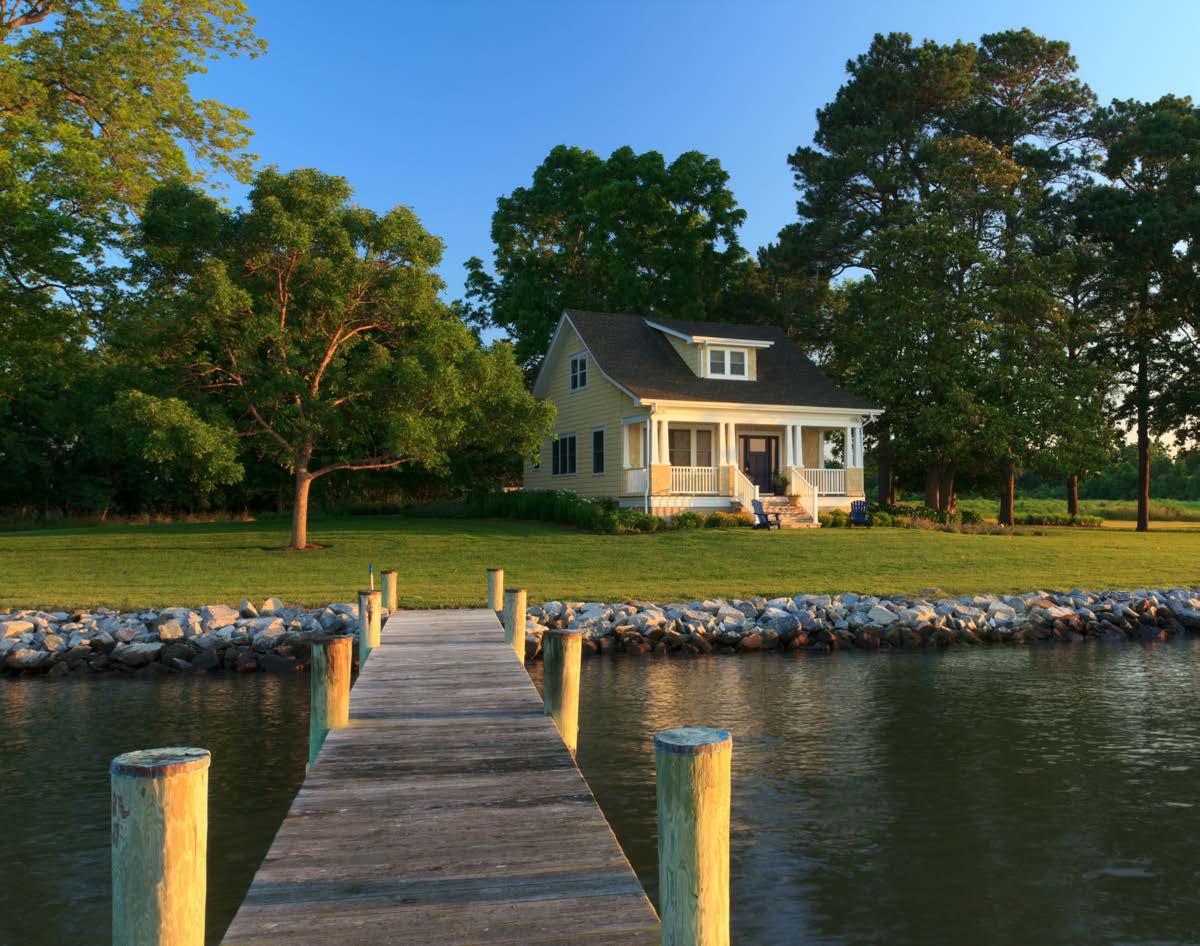
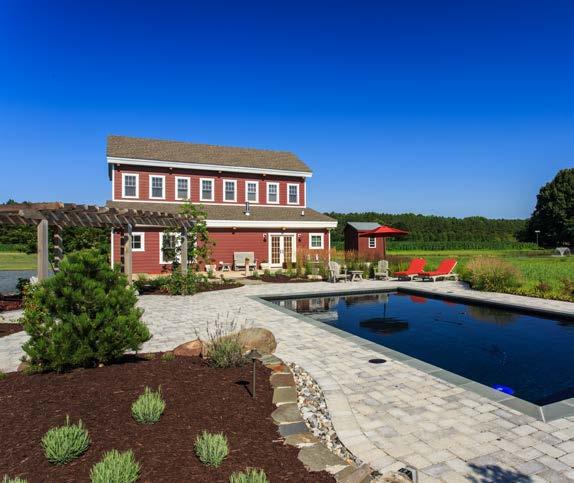

before the creative aspects of a project ever begin, which can include meeting Critical Area laws and regulations, and local zoning requirements. Civically, Dayton has been involved with the Talbot County Historic Preservation Commission and has stayed abreast of Talbot County’s comprehensive planning process. She prides herself in keeping up with the changing trends and regulations on the Shore to steer clients in the right direction at the start of a project.
“Our staff is well-informed of the rules and regulations, often
having to file the permits and deal with variances for our clients. The laws and regulations for homes near the waterfront can have a significant effect on the home design we create,” she explained.
Other issues affecting architects on the Eastern Shore include the effects of brackish air, which can be hard on building materials used in residential and commercial design.
“We are using more maintenance-free materials today that don’t require as much upkeep, as well as new building materials, which incorporate better
insulation, improved air quality, and natural lighting. All of this translates to a more aesthetically pleasing and more comfortable and efficient building,” she said.
Dayton said the uniqueness of the Shore inspires her work.
“I realize how lucky I am to live and work on the Eastern Shore — the lifestyle and experiences we get to share here are unique. I love designing homes that embrace the quality of life here,” Dayton said.
For more information about Dayton, visit cdaytonarchitect. com or call 410-822-3130. S
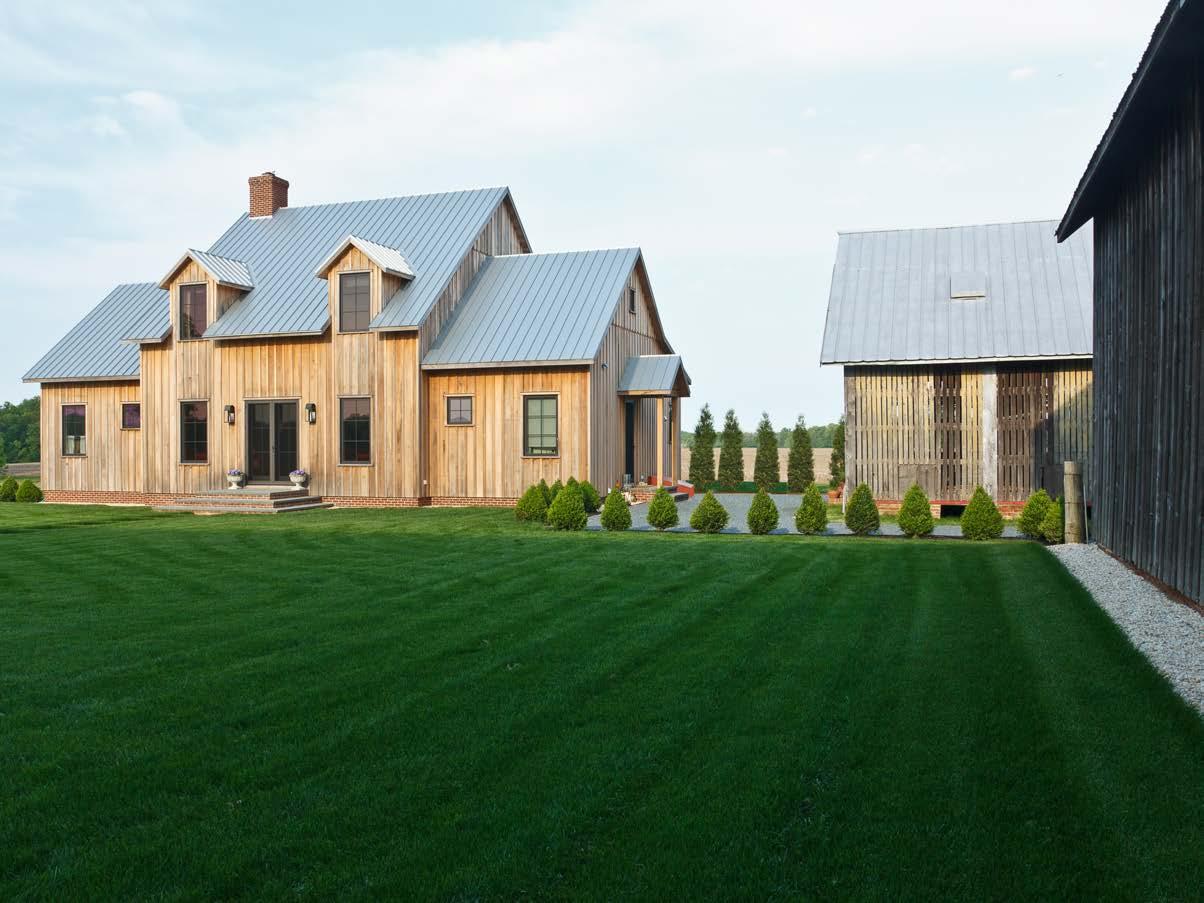




Tuckedalong aprivatecorneroftheMilesRiver, theInn’snauticalcharmandcasualeleganceinspirea genuinesenseofescapeand relaxation.
ByJennifer RobinMusiol,C-RNP,Certi edin AdvancedBio-identicalHormone ReplacementTherapy
Doyouseedeclininghormone levelsas anaturalpartofaging?Hormones affectyourenergylevel,yoursex life,yourabilitytomaintainmuscleand keepweightoff,andyourabilitytothinkclearly.Whyshouldyouhaveto livewith adecliningbodyandmind?Theanswerissimple: Youdon’t.
Fromage30onward,testosteronebeginstodroponetothreepercent each yearinbothmenandwomen.Inyour40s,youmaystartcomplainingabout “feelingolder.” Workproductivitymaydecline,youspendmoretimeonthe couchandyouronce-effectiveworkoutdoesn’tdeliverthesameresults.(The resultsinthebedroommaybedecliningalso!)
Carefulrestorationofthemajorsexhormones,plusstressreduction,some dietchangesandstrivingformaximalbodymovement,hasgivenmanythe vitalitytheyneedtoenjoylife.NewDay VitalityCenter(NDV)offersnatural bioidenticalhormonereplacementbyusingslow-releasepellettherapyfor womenandmen.
“Ididn’tthink Ineeded it,” saysNDVpatientSaroyaSewell.Sheremembers thatshelimpedintoourof celastyear.“Aftermy rstinsert, Ifelta vibrancyandalivenessinmybodythat Ihadn’tfeltforyears,” saysthe 57-year-old.“And Icanwalkfastwithoutpainnow.”
Rememberwhenyoursexdrivewashealthy,youfeltgreat,sleptlike ababy andhadmoreenergythanyouknewwhattodowith?Thenalongcomes menopauseandhercompanions:hot ashes,nightsweats,irritability,weight gain,sleepdisturbancesandfatigue. Wouldn’titbenicetoturnbackthe yearsandregainsomeofthathealthandvigor?


EASTON- StunningSouthern LivingDesign ~4 bedroom,2.5 BathCapeCodwith rst oor master suite, hardwood oors, hugescreenedporch anddeck overlookingprivatebackyard. Propertyo ers7.7+/-acres, separateshed,professional landscaping. $739,900

NewDay VitalityCenter’s hormonetherapyisdesigned speci callytohelpyouachievethenatural,healthy balanceofsexhormonesyourbodyneedstomaintain optimalwell-being.Thepellethormonedelivery systemactuallyreplenisheswhatdecreasesthroughthe agingprocess,usinghormoneswith thesamemolecular structureasthoseyourbodycreatedingreatersupply whenyouwerehealthyandinyourprime.

“Idecidedtotrythistherapytoget ajumpon andropause,” says41-year-oldErichJessup. “Myenergyisbetter,Isleep betterandthereis adifferenceinmymuscles:moreleanandlessbulk.”
Byrestoringyourhormonelevels, reclaimingyourvitalityandthrivingin ALLyour relationshipsispossible! Call410-793-5212todaytoschedule yourfreeconsultation.


EASTON- Charming andwell maintainedhomelocatedinthe Village at Cooke’sHope. 4BRs,3 BAs,high ceilings, hardwood oors, large roomsand separate mediaroom andstudio. Perfect turn-keyhouse with community wateraccess, nature trails,gym andtennis. $599,900
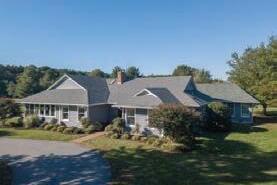
EASTON– This 3,200+/- sq rancher o Bailey’sNeck& Talbot Country Clubo ersanopen oor plan,4 BRs, 3BAs,hardwood rs, updatedkitchen,baths& fresh paint. Largerooms,naturallight, wood deckfor outdoor living& a well maintained& matureyard. Cul-de-sacloca on $699,900

EASTON– Completely renovated colonial. Neweverythinginside. Open oor plan,kitchen withisland, granite, stainlessappliances, rst oor master, 3bedrooms up with commonareaandlaundry. Large lot, maturelandscaping, o street parking, a ached garageand fencedinyard. $689,900





Cook Time: 50 Minutes
Serves: 2
Ingredients:
½ cup honey
¼ cup + 2 Tablespoons red wine vinegar
1 cup fresh-squeezed blood orange juice
(approximately 5 oranges)
1 ½ cups chicken stock
1 sprig of fresh thyme
2 duck breasts
Method:
To make the blood orange gastrique, place honey into a small saucepan. Cook over medium heat for about ve minutes, or until the honey turns to a dark amber color. Add the vinegar and blood orange juice to the honey. Bring to a simmer for approximately ve minutes, or until it starts slightly to thicken. Stir in the chicken stock and fresh thyme. Bring the mixture to a boil over medium heat and reduce the sauce to about a ½ cup, approximately 15 minutes. Strain the sauce through a ne mesh strainer and set aside. The gastrique can be made up to three days in advance, stored in the refrigerator, and rewarmed.
Using paper towels, pat the duck breasts until they are completely dry on all sides. Place them skin side up on a cutting board. Score the fat evenly with diagonal parallel slashes, being careful not to cut through to the meat. Season both sides with salt. Place the duck breasts skin side down in a large, cold cast iron pan over medium low heat.
Render the duck fat for 10 minutes, or until the skin is crisp and golden brown. Drain o the duck fat and reserve for future use. Flip the breast over and cook for an additional ve minutes, or until an instant read thermometer reads 130°F for medium rare.
Transfer duck to a cutting board and allow to rest for 10 minutes. Serve the duck with the blood orange gastrique and your favorite seasonal vegetables.
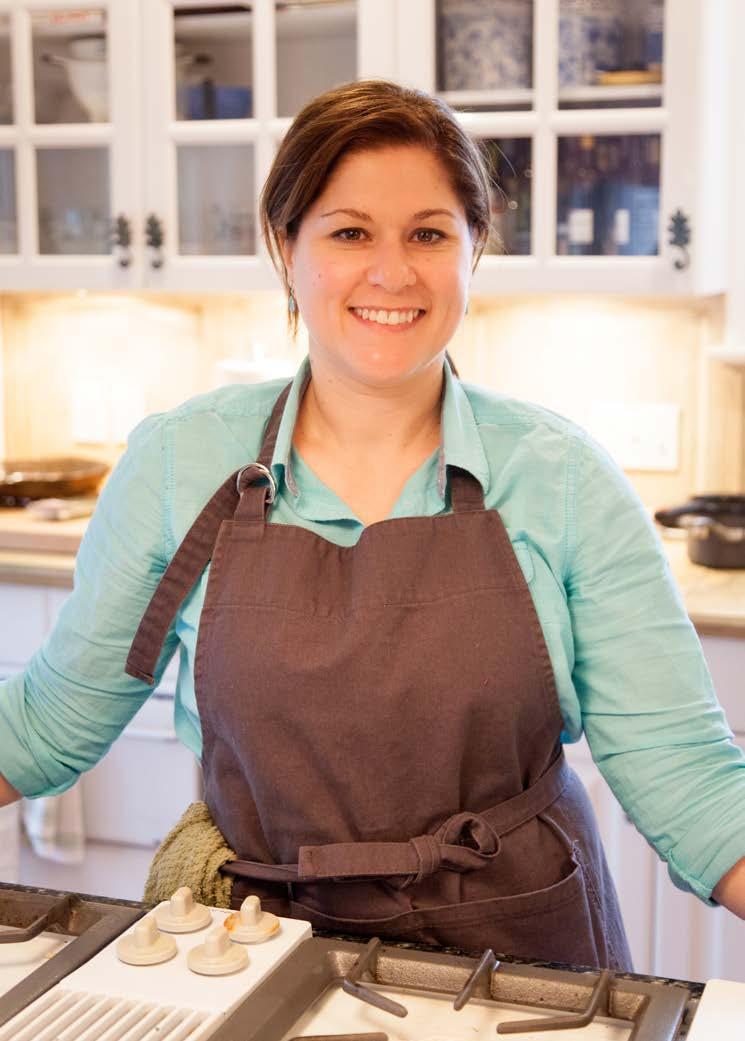
Diana Je ra grew up in Oxford and graduated from Gunston in 2001. She went on to graduate from the University of Maryland, Baltimore County with a degree in graphic design. Her love of food and art led her into foodservice marketing, but with an ever-present entrepreneurial spirit that she just couldn’t shake, she quit her job of four years to pursue culinary school with the intent of starting her own business as a food stylist. Before graduating, she spent a summer working abroad in Italy at Hotel Caruso, owned by Belmond. She now gets to create food for commercial photography and develops recipes for numerous brands. You can see her adventures by following her on Instagram @foodstylist_Diana or visit her website, www.dianaje ra.com. Mid-Shore residents Ryan and Allison Prell, friends of Je ra’s, graciously o ered the use of their kitchen for the March Shore Monthly “Local Flavors” photo shoot. Table settings available at Trade Whims in Easton.
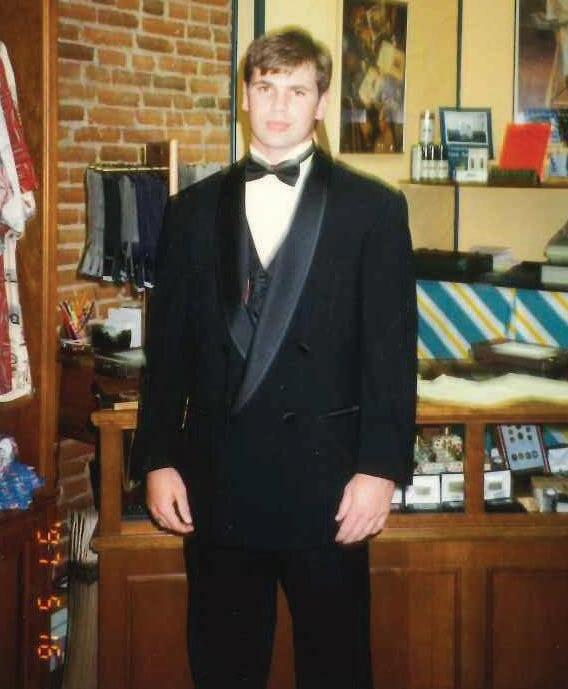
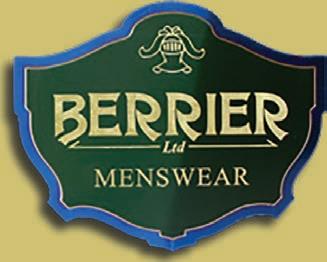






























HOUSES FROM EACH MID-SHORE COUNTY THAT REFLECT THE PERSONALITY OF THEIR LOCATION

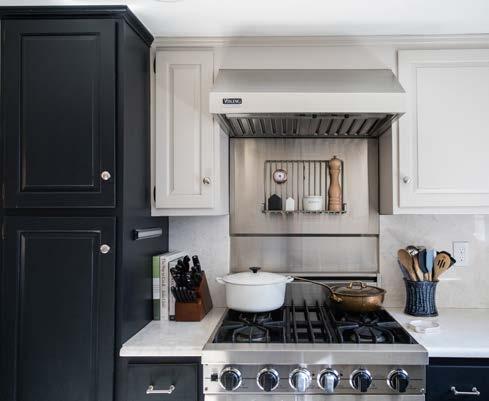
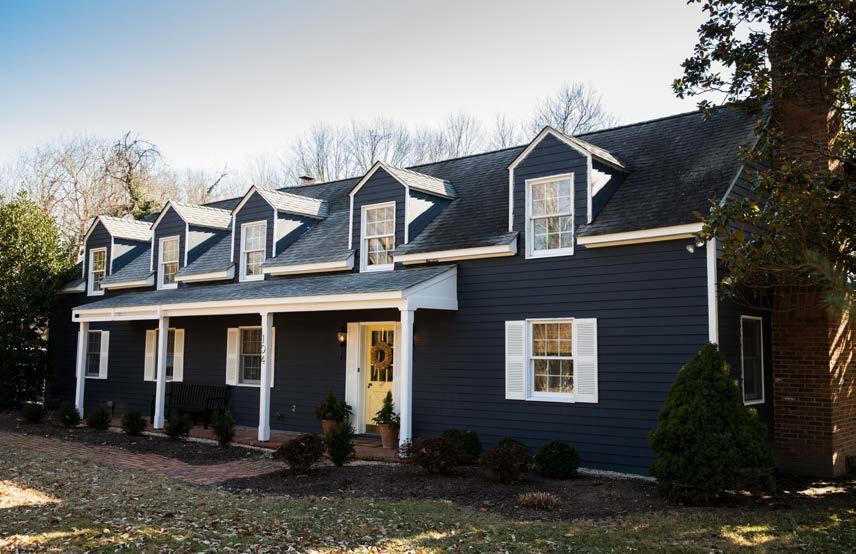
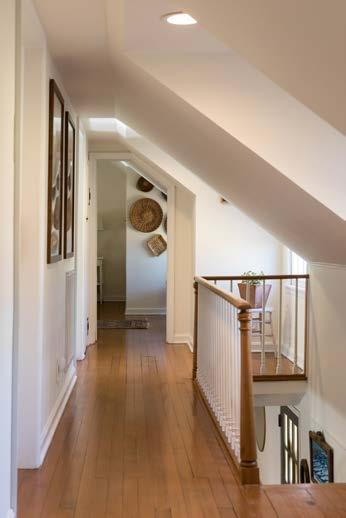


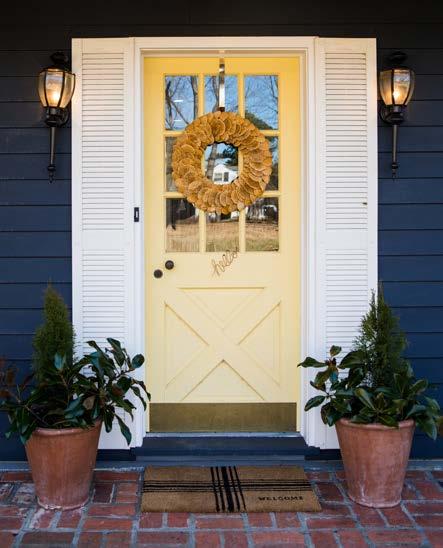
Carolina and Dylan Peter are high school sweethearts. Having gotten engaged in college, the couple purchased their home on Bennett Point Road, in the Governor Grason Manor 1 neighborhood in Queenstown, in December 2015. They moved in after returning from college in Massachusetts, in summer 2015.


When Carolina
Peter found her and her husband’s home, set near the Wye River, it was listed as a foreclosure, and it needed a lot of love. Carolina said the home and its renovations have been “a fun little endeavor as newlyweds in this season of life.”
Story by Katie Willis
by Caroline J. Phillips
When Carolina found their home, set near the Wye River, it was listed as a foreclosure, and it needed a lot of love, she said. Although the listing said the home was built in 1970, it appears after some research on Carolina’s part, that that was when the addition was built onto the house — a master bedroom and living room — but not when the main part of the home was built. She said that still remains a mystery, although she and her husband believe it to be the former carriage house for Governor William Grason.
She said there also was a Grason family farmhouse on the property at some point, but it no longer is there. However, there is a historical grave marker located in the back yard of their neighbors house, which stands where Grason’s farm house once was, that could offer some clues to the property’s history.
Today, the home, with its low ceilings, has evolved into a do-it-yourself masterpiece. Dylan is a marine engineer, who in the early part of homeownership, would have to ship out for three weeks at a time. Carolina began an Instagram account, “My Three Week Fix,” to document the DIY and renovation of their first home.
“I was trying to stay busy while he was away,” Carolina said. “He works landside now. He helps with a lot of projects, he’s very handy. He has that engineer brain.”
Carolina said Dylan taught himself a lot of the aspects of the renovation projects, including building built-in storage, adding outside lights and adding recessed lighting to brighten up the
rooms. They recently took the drywall ceiling down in the dining room, to get to the exposed beams, and later added in a false wooden ceiling. This past summer, they hand painted the entire outside of the home.
When they first moved into the home, Carolina said it was livable, but they wanted to make it more their style. She said when they moved in, one of the rooms had tropical-style wallpaper with monkeys on it.
The hardest part about owning an old home?
“Every room requires a little extra TLC. You can’t just go in and paint a room. You have to fix some trim that’s uneven, or there’s weird electrical wires. Nothing’s even,” Carolina said.
She said an old house has a lot of quirks, and because it is not a new build, much of the renovations have to be done piecemeal.
“We wanted to keep the integrity of the house and let those quirks show through because that’s what we fell in love with,” Carolina said.
She said one of her favorite quirks of the house is, “the whole upstairs has these adorable little old doors with dark hardware.” She said there also are a host of built-in drawers and cabinets.
“All these little spaces that they made the best use of,” Carolina said. “Dylan and I are a little quirky anyway, so this house kind of ts us. It lets our creativity shine through. I couldn’t see us in a new build. I think we secretly love (the quirkiness of our home).”
Carolina said the home and its renovations have been “a fun little endeavor as newlyweds in this season of life.”
“I feel very blessed that we have this opportunity. We bought this as 23-year-olds. Not every 23-year-old gets this opportunity,” she said.
Located along the Choptank River in Cambridge is a little more than 8 acres of land, interspersed with a diversity of ecosystems — a beautiful view and access to the Choptank, lovely beaches, and a pond formerly home to a terrapin farm. And on this little slice of heaven also sits the home of Curt and Paula Singer.
“One of the things that attracted us to the property was the many ecosystems,” Paula said.
The Singers purchased the property in 2004 and began building their home in 2008. Paula said when she and Curt began dating, he promised her he would build her her dream home — one overlooking a river. Thirty years later, she said, he delivered.
“We were high school sweethearts,” Paula said. “The journey of saving and planning for (our home) was exciting.”
Paula said it wasn’t just a sense of accomplishment when they nished building their home in 2010, but also the realization of a dream.
“To have a gathering place — the house is filled between Memorial Day and Labor Day — realized our hopes for having immediate and extended family enjoy time together and stay close,” Paula said.
Paula said she and her husband hired some of the finest professionals available for the project; Gary Smith became their general contractor; Hammond Wilson, their architect; and Kristin Peake, their interior designer.
“It was a wonderful experience, marvelous. Not the disaster experience that everyone warns you about,” Paula said.
Paula said she has been scrapbook-designing homes since she was 10. She and her husband have renovated properties before, and they own rental properties, so the process of building and designing a new home was not entirely new to them.
“We think that’s fun. Our experience helped us to have high but realistic expectations. Because we understood the process, I think we were able to be good customers, too — clear with our needs and desires, and willing to let the experts do what they do best in helping us realize our vision,” Paula said.
She said they also wanted to be good neighbors.
“We wanted to be careful and conscious of the views that the neighbors had enjoyed for years before we bought the property,” Paula said.
In being conscious of their neighbors, they placed their home in a different spot than originally intended, so as not to a ect, and help to preserve, their neighbors’ views of the Choptank River.
When choosing their architect, they chose Hammond Wilson because they appreciated the kinds of homes he designed, saying he paid homage to the “traditional style they enjoy, giving close attention to every architectural detail, and ensuring the result not only looked beautiful, but felt beautiful too.”
“He understood we were not trying to build some big, ornate house. What we wanted was a home with timeless elegance and an atmosphere of welcome and warmth,” Paula said.
She said she and Curt were looking for a home that was reminiscent of the Nantucket style, with detailed woodworking and ceilings, and lots of windows.
“The details of the moldings, door trim, gambrills, and built-ins are architecturally stunning, but subtle, so you’re not overwhelmed. It has elegance, but also comfort. To us, it is a home that is both unique and warm,” Paula said.
What they got was exactly what they wanted, Paula said, and she agreed it was because of the way she and her husband, who were very involved in the process of building their home, were cohesively able to work with Smith, Wilson, and Peake.
“You hear so many horror stories about building. But in our case, we were fortunate enough to nd an architecture rm that truly listened, a general contractor who built the home as if it were his own, and an interior design team that made it all come together,” Paula Singer said. “The chemistry was exceptional and the result was a home we love and feel blessed to have.”
Story by Katie Willis
Photos by Caroline J. Phillips






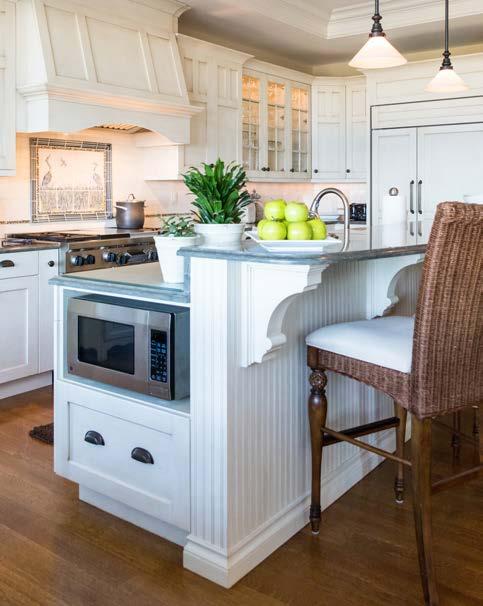

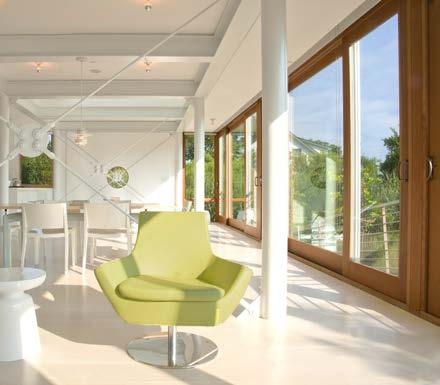
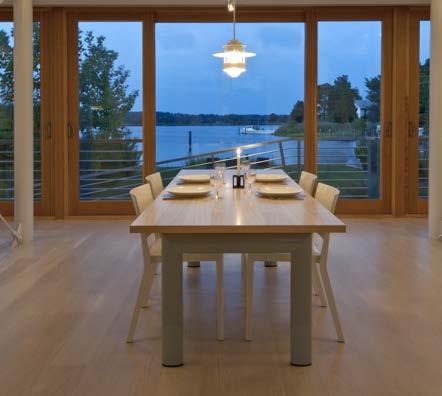






Story by Danae Spiering
Photos
submitted by
Julia Heine/ McIntur Architects
Nestled among tall pines, cattails, marsh grass, and quaint seaside cottages stands a unique cedar-clad modern dream home. Complete with a rooftop pool and an endless supply of water views, architect Mark McInturff’s house in Neavitt not only embraces the Eastern Shore’s picturesque scenery, but it showcases the easy, breezy lifestyle the Shore knows so well.
An architect by trade, Mark knows a few things about design, scale, and the hustle and bustle of city life. Most of his time is spent in his o ce and primary home in Bethesda.
“Someone once said, ‘When building a vacation home, it should be different than your house — somewhere to get away — and I think that is a very good point,” Mark said.
That theory was his inspiration when building his Neavitt home. In Bethesda, his home is more traditional, less minimalistic, and near his architectural firm. He stays in work mode while there. But in crossing the Bay Bridge, he said he is able to leave that world behind and focus more on recharging his batteries.
“When I cross that bridge, I can relax,” Mark said. “It is healthy for me, it’s like I can exhale.” While he does have a drafting table and work space cut out in his vacation home, he said it is not like working in the city — “Even (work here) is relaxing.”
His two homes seem a world apart, much like the focus he keeps within them.
It’s here on the Shore, among the hum of boats, waves, and wildlife that he nds a place to recharge his batteries and break away from the hustle and bustle of the western shore.
“Out here is very different — clean lines, open views. It is the perfect winter and summer house,” Mark said.
Mark describes his summer getaways in the house.
“Swimming on the roof, overlooking the water is pretty fabulous. You’re 40 feet up in the air. You can see a lot of the Eastern Shore from 40 feet,” Mark said. “This house is de nitely a family-friends thing. It is great for relaxing, paddling, and just having a beer on the roof.”
The roof is perhaps the key design element and determining factor in the overall look and structure of the home.
“I knew I had wanted a swimming pool on the roof, so the house is kind of like a tube of toothpaste,” Mark said. “You squeeze the tube and it ends up coming out of the top.”
Due to the weight of the pool, and gallons upon gallons of water, Mark had to use a lot of steel, which led to the overall modern design and strength of the home.
While the rooftop and the pool are his coveted spot in the summer, Mark nds solace during the long winter nights in front of his cozy replace. He said his house serves as a constant year-round retreat.
Other factors went into the overall finished look of the home, including being limited to the lot’s original home’s footprint. Even though the lot was empty when Mark purchased it years ago, the foundation of the former home still was present.
Unable to expand outward, up seemed like a natural solution. So Mark reached for the sky and designed his three-story sanctuary.
He said, at rst, the neighbors had mixed reviews about the modern, boxy structure, but, “By adding the cedar shake exterior — which is very traditional, and has since weathered, it is blending. It is not like other houses around it, but I think it ts in. Now I think it is just part of the town,” he said.
The Second Empire Victorian overlooking the Choptank River in Denton’s historic district drew Steve Konopelski and Rob Gri th to Turnbridge Point, 119 Gay St., but once inside, the original woodwork, pine oors, stained glass windows, doors, hardware and curved, three-story staircase, captured their hearts — and imaginations.
“This house had everything we were looking for,” Konopelski said. “Originally, we wanted something more secluded, with some acreage (for our bed and breakfast inn), but once we walked outside and saw the backyard — and there is this feeling of seclusion in the back of the property — it ticked all the boxes.”
They purchased the house in 2014. Built in 1868, and originally a two-story home, the third story and distinctive mansard roof were added in 1890. Now a 13-room inn, it boasts a wide, inviting front porch with two more on either side.
Originally from rural Saskatchewan, Canada, Konopelski is a former Broadway dancer and performer who retired from the stage and became an award-winning pastry chef. He set up his bakery in the back of the inn, while Gri th, a patent attorney who telecommutes to his rm on Long Island, N.Y., has an o ce at the inn overlooking the river. Their home is the carriage house behind Turnbridge Point.
What drew them to Denton also is what attracts guests to the inn.
“We want it to look great when you walk in the door, but we want you to feel like you’re home,” Gri th said.
The parlor on the right of the entrance foyer is the most traditional room, with matching Victorian wing chairs bought at a local antiques store. But the “fainting chaise” in the center of the space has contemporary lines and fabric.
“We tried to offset heavily antiqued furniture with something contemporary,” Gri th said.
“We didn’t want chintz, and doilies, and chenille,
and creepy porcelain dolls,” Steve said. “It is a Victorian house, so why not pay homage to the Victorian parlor?”
“The color palette was deliberately chosen because we wanted to have this nod to nautical, and coastal, and beachy without slapping you in the face with anchors, and rope, and star sh, and crabs everywhere,” Konopelski said.
The library on the other side of the foyer is a blend of traditional and contemporary, as well. A leather chair, tufted linen couch, and contemporary rug rest comfortably in the 19th-century space. On the walls are framed posters of the Broadway musicals in which Konopelski has appeared.
The rich colors in the stained glass panels that surround many of the windows form the motif for the muted hues in the inn’s ve bedrooms, each named for former owners of the house.
Throughout the inn, six large contemporary paintings by Rob Brownlee-Tomasso accentuate the space, topped by nearly 12-foot ceilings on each oor.
The bolder, rich, deep red in the dining room picks up one of the colors in the stained glass panels.
“We didn’t even know stained glass windows were in the dining room,” Konopelski said. He said they tore down every inch of toile to reveal the distinctive windows. White wainscoting and crown moulding and a trio of large, contemporary paintings of local birds by Brownlee-Tomasso complement the dramatic e ect.
Outside, guests can stroll to the pergola-covered patio down to the sandy beach to lounge in Adirondack chairs and enjoy a view of the river and the old railroad bridge turnstile from which the inn derives its name.
“It’s very cute and charming, relaxed and quiet,” Konopelski said. “We get a lot of people who want a quiet, rural setting, just to get away.”
For more information, visit turnbridgepoint.com.
Built in 1868 and originally a two-story home, the third story and distinctive mansard roof were added in 1890. Now a 13-room inn, it boasts a wide, inviting front porch with two more on either side.
Story by Connie Connolly
Photos by Caroline J. Phillips
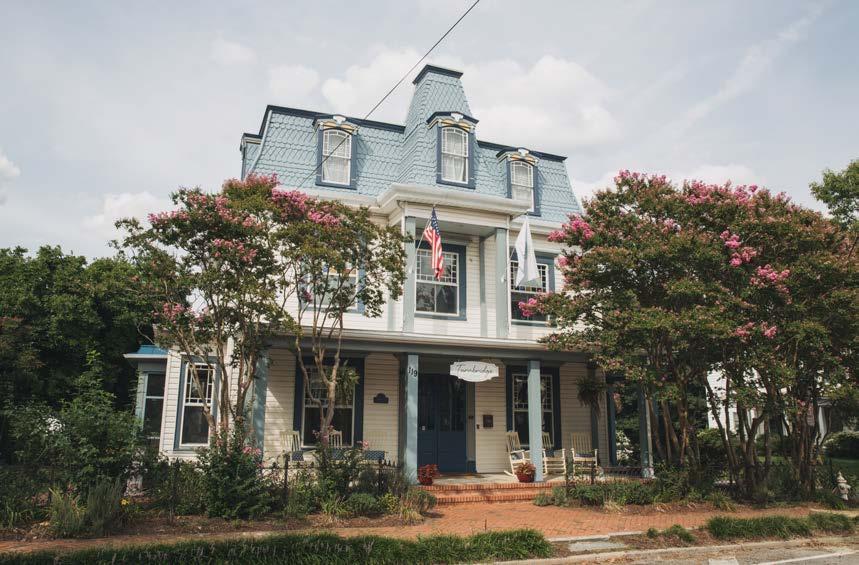
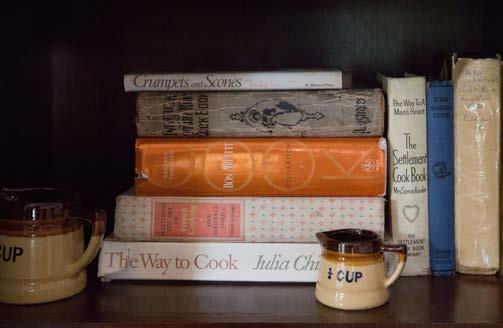
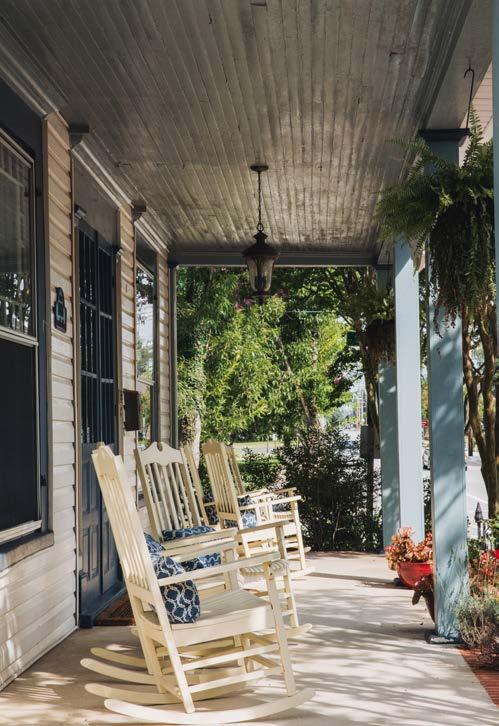
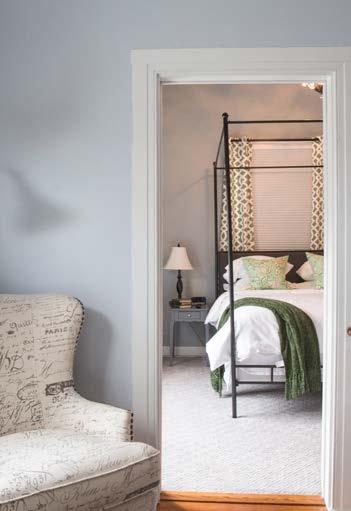


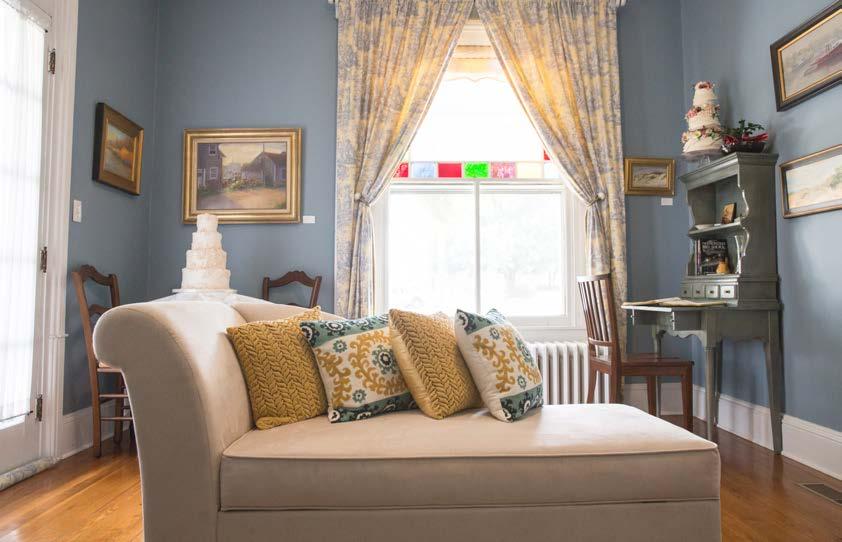

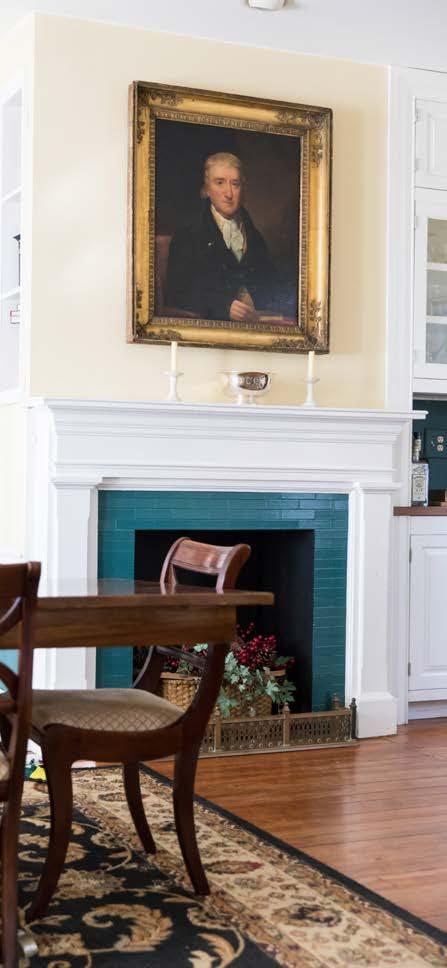
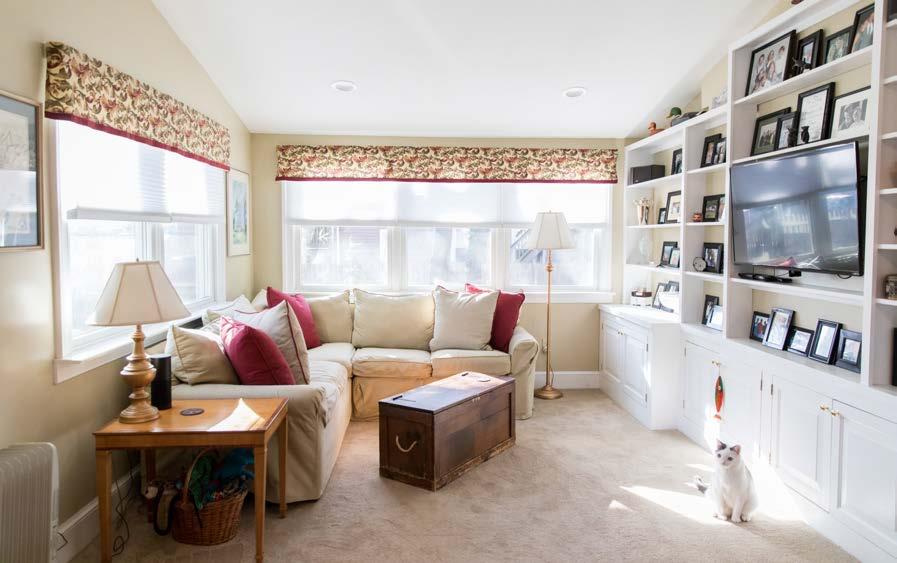
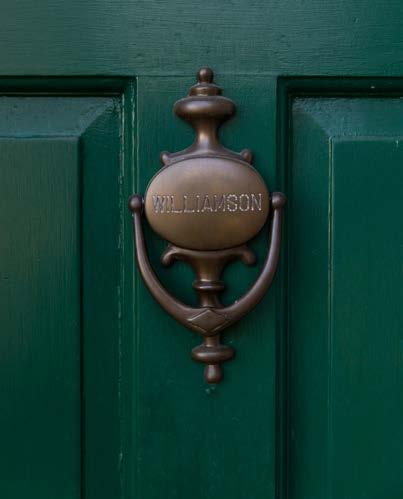
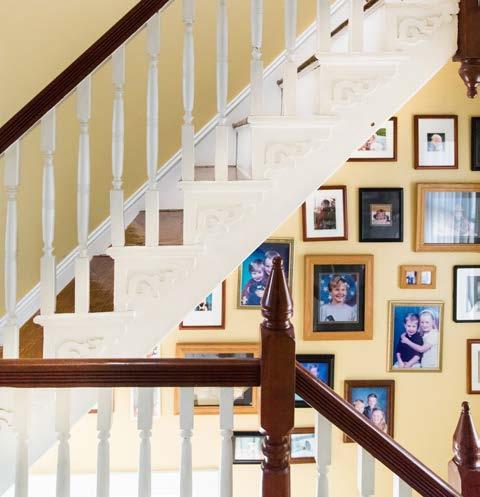


“This house has been a learning experience for all of us. The kids learned that not everything is perfect, not everything has to be new, and, most importantly, they learned how to do stuff,” Trena Williamson said.
Story by Denae Spiering
Photos by Caroline J. Phillips
In the heart of downtown Chestertown lies a house full of history, challenges, and love. Built in the late 1800s, the home of Trena and Kirk Williamson has had its fair share of “diets” over the years.
“You just kind of marvel at the weight of the wood and the size of the nails that they used, and just kind of say — ‘Wow,’” Trena said. “That has been the most fun, to take stu down and to see how things were built.”
Once standing in full Victorian-era garb complete with a wrap around front porch, large bay windows, German shiplap outer-shell, and plaster-covered walls throughout, to its now sleeker cedar shake exterior, dry wall interior, and custom built-in shelving, the house has undergone major renovations.
Kirk bought the home in 1992, and had done minimal work until he married Trena.
Realizing their century-plus old home did not quite meet the needs of their family of ve, the gutsy couple began to renovate the old girl room by room. With Kirk serving as handyman and Trena being the caulker and painter, the can-do couple have become experts in showcasing the past while embracing the needs of the present.
“In the summer of 2001, we really started the major renovations,” Trena said. “We did the entire third oor, creating two bedrooms and an open landing area for the kids’ den.”
As the couple moved from room to room, floor to oor, they made sure to save the architectural details of the home. From antique re place tiles, which required some quick thinking and salvage shopping, to the replication of perfectly carved, scalloped woodwork.
“One of the things I love most about my house is the scallop pattern in the moldings,” Trena said. “We
had our builder replicate it throughout the home — wherever we added storage or a built-in. It helps those items to look original — you wouldn’t know it wasn’t.”
The renovation has taken years to complete, and hasn’t always been easy.
“Nothing is ever square. We just kind of look at each other and think, ‘What in the world?’ It is the frustrating part, and yet the charming part, as well. We learn and laugh with every room we do.”
Living in an old home requires give-and-take, along with a little ingenuity. But what it gives in return is something that cannot be found in a newly built home.
“It takes a special kind of person. You have to be the right kind of people to love an older home. It is not for everyone,” Trena said. “You’re going to have dust, and things not going to be square, but you have to work with the house as much as it works with you. There is nothing like an old house — you feel so safe in it. You know it has been here this long, through storms and anything else over the years, and will continue to be as long as it is cared for.”
Now that the couple’s kids are grown and all but one has moved out, they have considered hanging up their hard hats for a simpler life, one without the aches and pains of an older home.
But, Trena said, “The closer I get to that, I just cant imagine doing it. This house keeps us busy.”
She said the more they see, the more they do, and they always are asking themselves what is next on the list.
“It is in our nature to tinker. Even if we bought new, we would nd projects,” Trena said. “So, why not stay where we have made memories and done so much work?”












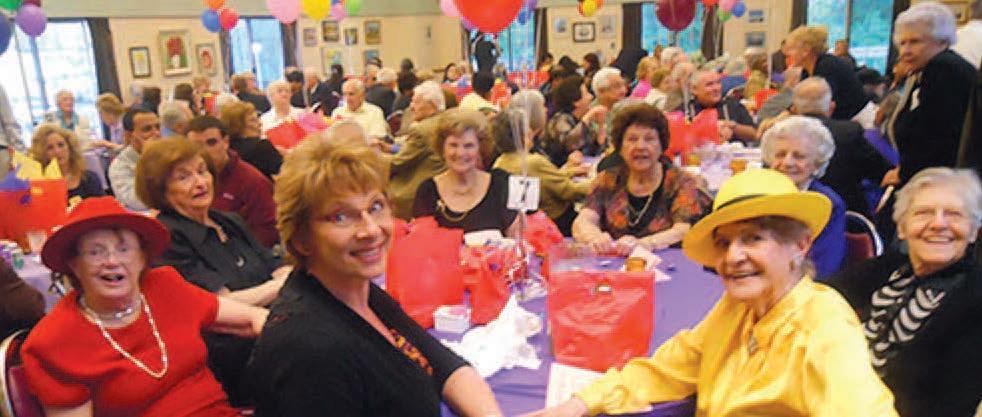
















Located on a street corner in the heart of downtown Denton, Market Street Public House is hard to miss. Owner Brian Tyler has embraced the role of hometown staple, with tables made from wood found in Caroline County barns and pieces covering the walls refl ecting local history. It’s a neat mix, and one that’s been embraced by visitors and locals alike.
You really can’t go wrong with anything on the menu, but there’s a few pairings that really capture the deliciousness of this classic pub fare.




If you’re looking to break the St. Patrick’s Day Guinness habit without going totally cold turkey, why not eat rather than drink it? Market Street’s Guinness burger is half a pound of fresh ground beef topped with bacon, caramelized onion marmalade, smoked Gouda, and a Guinness aioli. And it’s delicious. This burger is big and juicy, and really everything you want when you order a burger — something that leaves your mouth watering after the first bite and gives you plenty more to follow it up with.

So, what do you drink with this burger if not a Guinness? One of Market Street’s own beers, an Irish red ale, stays on tap at all times. The “red” moniker comes from its color, and it’s a well-balanced beer that serves as a nice alternative for someone who doesn’t want the bitterness of an IPA.

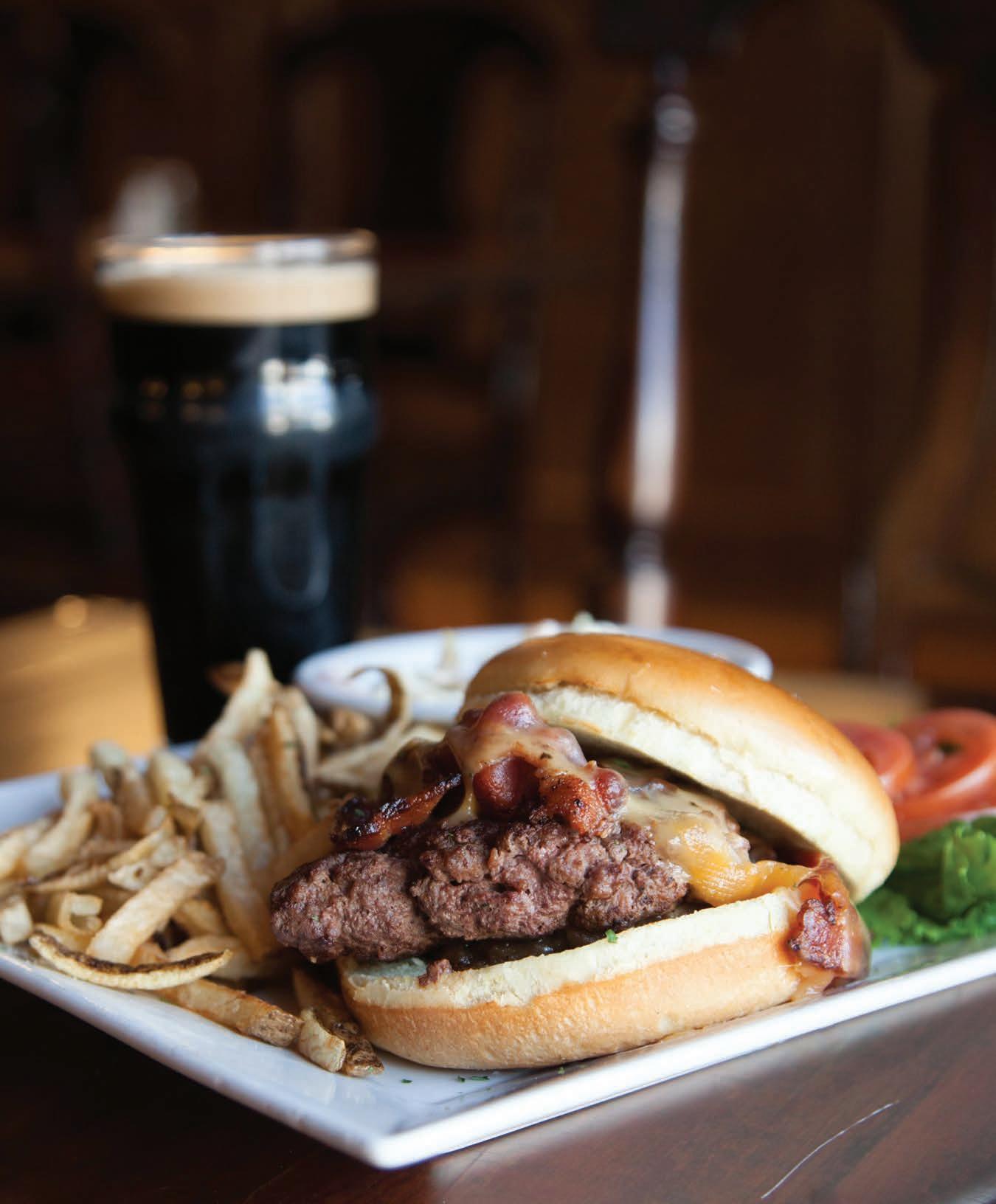

This pairing isn’t exactly Irish, but it’s got a great flavor to look forward to with the approach of spring and warmer weather. Grilled chicken on a bed of mixed greens tossed in sesame ginger dressing and spicy peanut sauce with green pepper, red onion, and carrots, all served on corn tortilla chips, it’s incredibly light and refreshing. Just picture yourself enjoying the crisp kick of this Thai-infused salad while you dine outside and soak up the sunshine.
You’ll want to keep your drink light with this meal, too, so consider staying away from the beer and opting for a cocktail instead. Tyler recommends a Dublin Dew, made with fresh lemonade, melon liqueur, simple syrup, lemon vodka, and a splash of Sprite. Its sweetness provides a nice contrast to the spice of the salad, and the combination of the two prevents either from being overwhelming.


If you think you’re going to have room in your stomach, start with the Irish baked potato soup, a real treat served with homemade garlic crostinis, or finish off your meal with the bread pudding and an Irish coffee, two nice options to complete your dining experience without killing you with sugary sweetness.
You’ll need more than one trip to Market Street to really explore the menu the way it deserves, but it’s affordable and worth it.
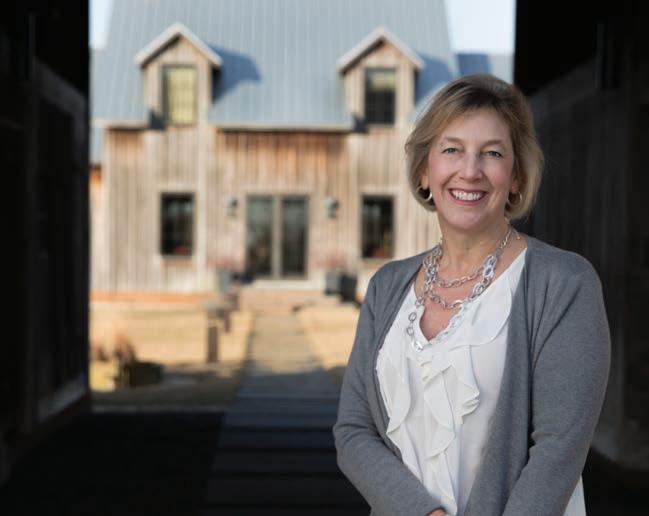
Architect Christine Dayton of Easton is the principal and owner of Christine M. Dayton Architect P.A. Her projects on the Shore range in scope from small residential homes, to grand estates, and from historic commercial renovations to industrial buildings. She is a licensed architect in the state of Maryland and the District of Columbia, and works with a sta of four in her Easton o ce. The March Shore
Monthly cover photo was taken at a new residence Dayton designed in Old Wye Mills.
Cover photo by Caroline J. Phillips.



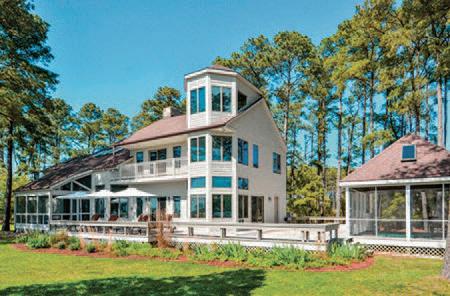
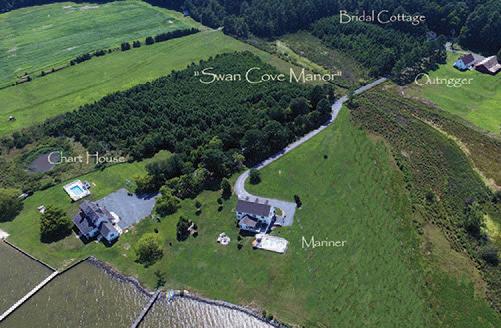
SWANCOVE MANOR VacationandweddingvenueontheChesapeake Ba y.Features5homes,3poolsand3piers. Thousandsoffeetofpropertyshorelineand newlyrenovatedhomeswithexcellentrevenue streams.Callmeforapersonaltourtoday! $2,895,000 www.swancovemanor.com

2-carattachedgarageand4-cardetachedgarage w/apartment.Pool,spa,tenniscourt,dockw/ boatliftand7+/-MLWatpier.Offerswaterfowl impoundmentwithwell,highelevationand protectedshoreline. $2,385,000



West Marine
8226 Ocean Gateway, Easton
410-770-3080














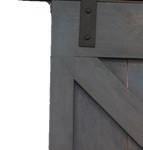

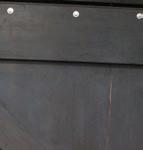

































www.easterninteriors.com HEAVY DUTY HANGING WIRE






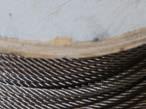




CHESAPEAKE-INSPIRED ANTIQUE FURNITURE
Stevensville Antiques 105 Market Court, Stevensville 410-643-9533






























West Marine


8226 Ocean Gateway, Easton 410-770-3080 UNIQUE






Eastern Interiors 329 High St., Chestertown 443-282-0215























